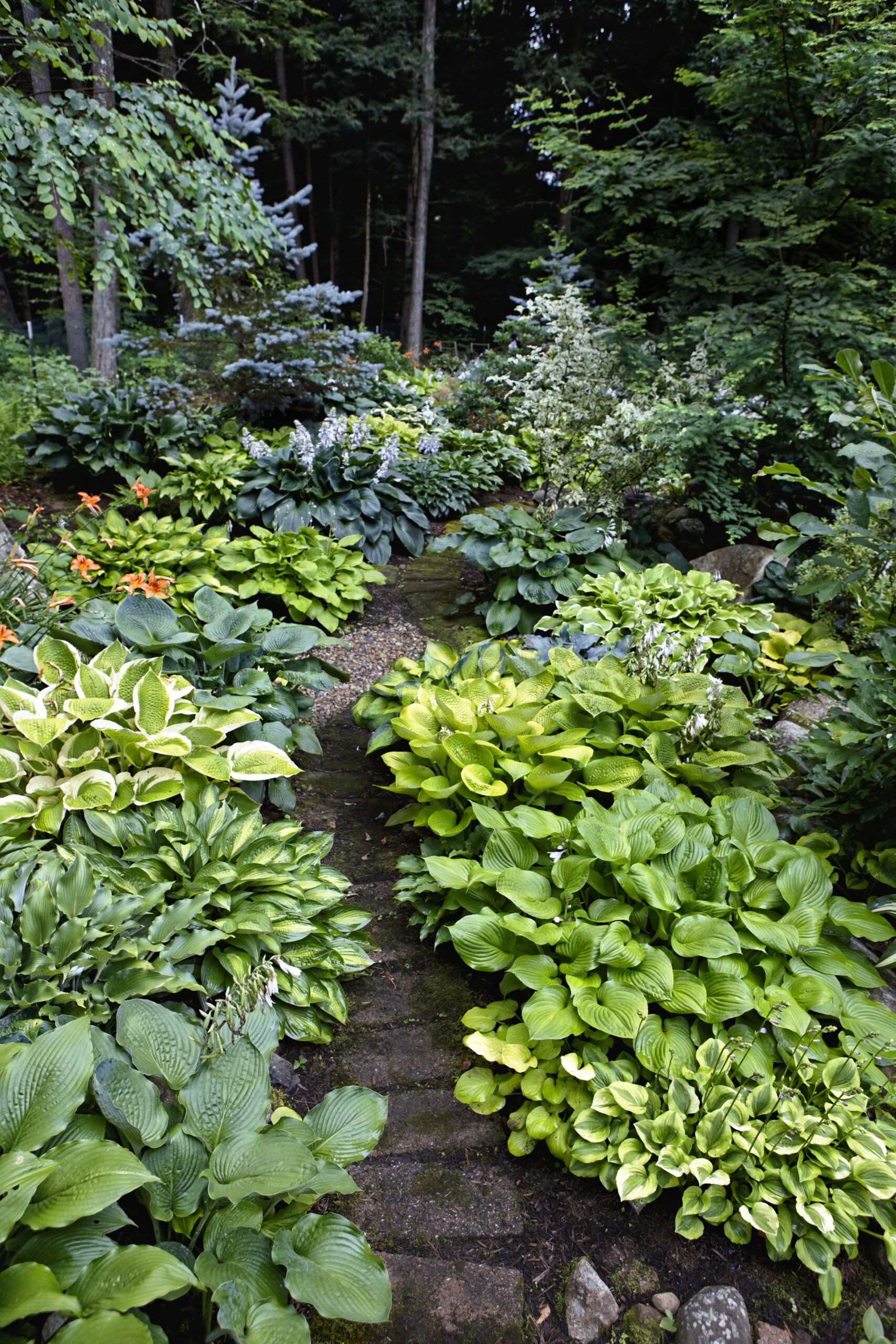Hostas are the perfect solution for transforming shady areas of your yard into lush, vibrant oases. These versatile perennials offer a wide range of colors, sizes, and textures, making them ideal for creating stunning shade gardens. With their ability to thrive in low-light conditions and minimal maintenance requirements, hostas have become a favorite among gardeners looking to add beauty and interest to challenging spaces. In this comprehensive guide, we’ll explore the world of hostas and how to use them to create a stunning shade garden that will be the envy of your neighborhood.
Durable, Colorful Foliage With Hostas
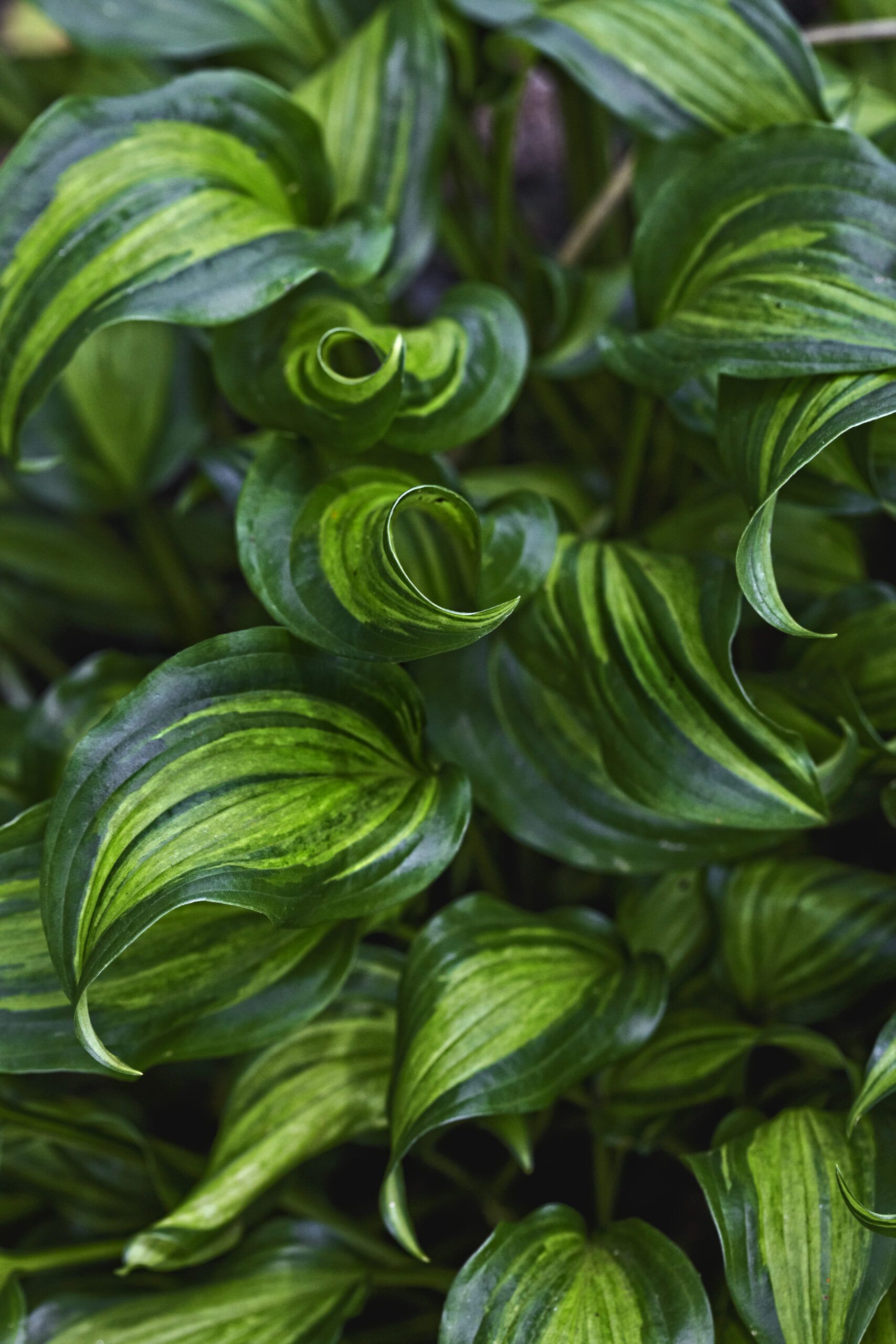
Hostas are renowned for their striking foliage, which comes in a variety of colors, shapes, and sizes. These hardy plants are native to China, Korea, and Japan, where they naturally grow in woodland areas and along streams. Their popularity in American gardens skyrocketed in the 1980s when breeders successfully developed new varieties with unique variegation patterns.
The leaves of hostas are not only visually appealing but also durable and inviting to touch. Unlike many delicate perennials, hosta foliage can withstand attention and interaction, making them perfect for creating tactile garden experiences. Their leaves typically feature a velvety matte finish, adding depth and texture to shady garden spaces.
Hosta colors primarily come in three core shades: green, blue, and gold (including chartreuse and yellow-tinged varieties). Variegated varieties often combine two of these colors or pair them with white. Some newer cultivars boast three-color combinations, offering even more visual interest to these charming garden staples.
Sun Tolerance and Color
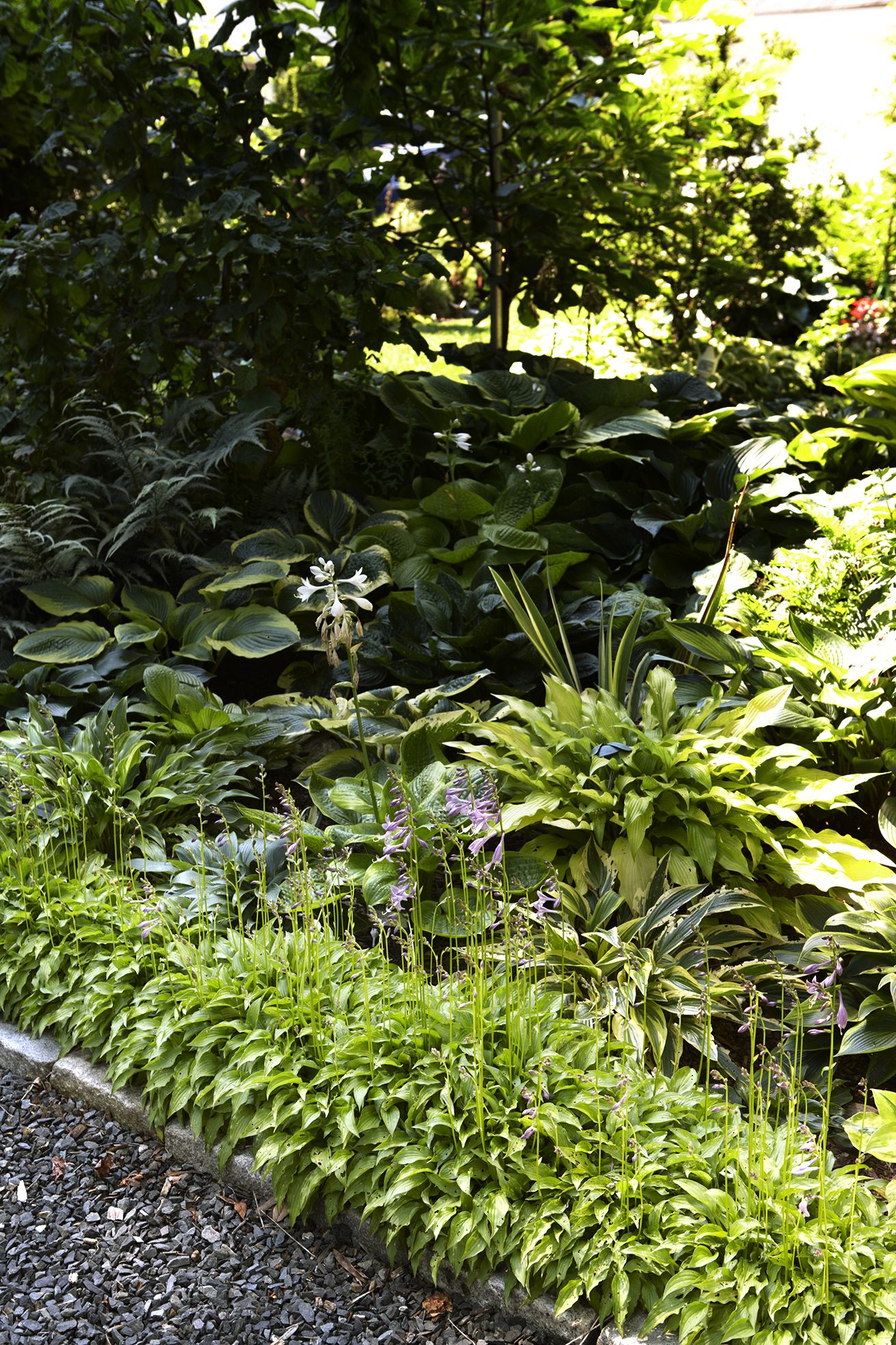
While hostas are primarily known as shade-loving plants, they can tolerate varying amounts of sunlight depending on the variety. Most hostas thrive with three to six hours of morning sun, but think about each variety’s specific needs for optimal growth and color retention.
Brighter chartreuse and gold cultivars generally tolerate more sun exposure, while blue hostas are particularly sensitive to excessive sunlight. Too much sun can cause blue hostas to lose their protective waxy coating, reverting them to their true green color. White or mostly white hostas typically require more light than their colored counterparts, as they lack sufficient chlorophyll to thrive in deep shade.
It’s important to note that afternoon sun, especially in warmer climates, can stress hostas and cause leaf fading. To maintain vibrant colors and healthy growth, follow these tips:
- Monitor leaf color and adjust placement if fading occurs.
- Plant blue hostas in areas with filtered light or morning sun only.
- Provide additional shade for white hostas in hot climates.
- Use gold and chartreuse varieties in spots that receive more sunlight.
Shown: Lining a walkway with ‘Lemon Lime’ mini hostas creates a clean border and allows taller varieties, such as golden ‘Pineapple Juice’ (upper right), to stand out.
Susceptible to Garden Pest Damage
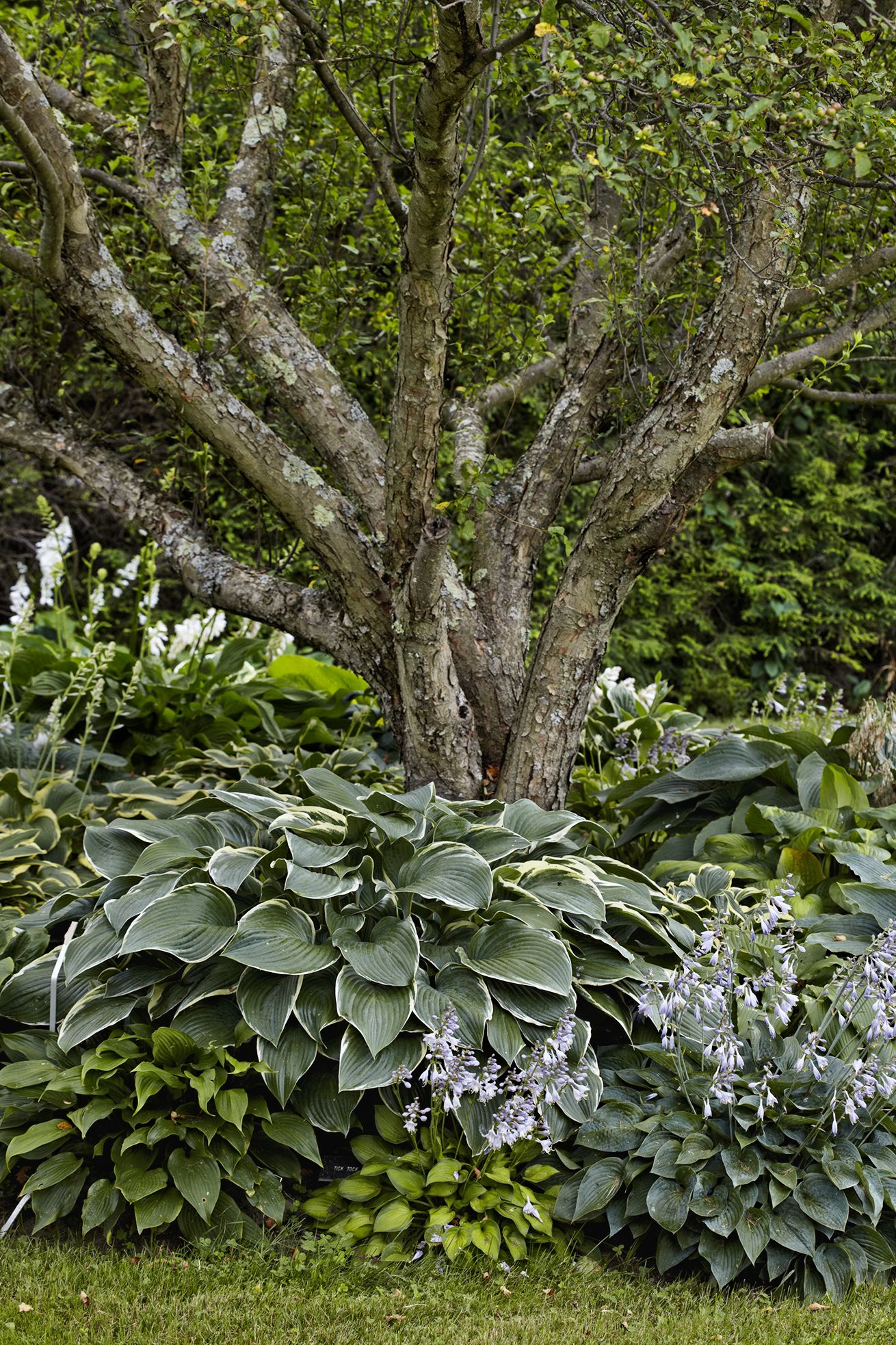
While hostas are generally hardy and disease-resistant, they can fall victim to various garden pests. Common culprits include deer, voles, rabbits, and slugs. These pests can cause significant damage if you don’t manage them properly. To protect your hostas from these uninvited guests, implement some effective strategies.
Use physical barriers such as fencing or netting to deter larger animals. Apply organic slug repellents or set up slug traps to keep these mollusks away. Select hostas with thicker, more textured leaves, which are naturally more resistant to slug damage. Surround your hostas with plants that deter pests, such as lavender or marigolds, which add both protection and beauty. Despite these potential challenges, hostas remain a popular choice for gardeners due to their resilience and adaptability. They can thrive in a wide range of climates, from the coldest parts of Minnesota (zone 3) to Central Florida (USDA Hardiness zone 9), withstanding temperatures as low as minus 40 degrees Fahrenheit.
Shown: When a lawn runs right up to the base of a tree, mowers and string trimmers can damage the trunk. Ringing the tree with shade-tolerant hostas safeguards the bark and creates a focal point in the yard. Here, the large, variegated leaves of ‘Tom Schmid’ tower above smaller varieties.
Anchor Plants
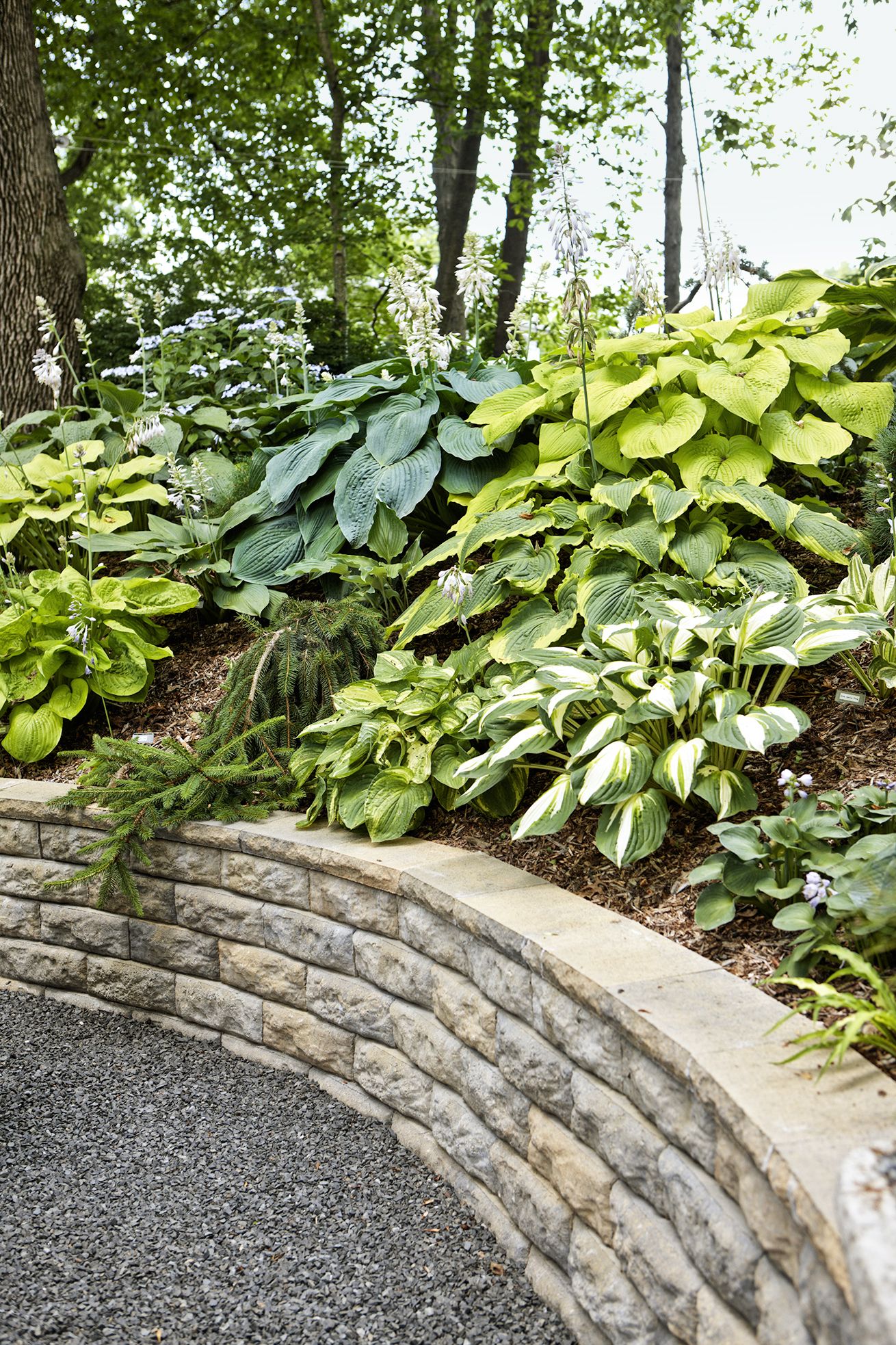
Large hosta varieties make excellent anchor plants in shade gardens, providing a strong focal point and structure to your landscape design. These jumbo hostas can reach impressive sizes, with some varieties growing up to 6 feet wide and 4 feet tall. Their grandeur and striking foliage make them ideal candidates for anchoring and unifying various garden design elements.
Provide ample space for growth, allowing at least 3–4 feet between large varieties. Fertilize regularly with a balanced, slow-release fertilizer to promote healthy development. Check for consistent moisture, especially during hot summer months when the risk of dehydration is higher. Mulch around the base to retain moisture and suppress weeds that may compete for nutrients. One standout variety for use as an anchor plant is ‘Empress Wu,’ which boasts dinner-plate-sized foliage up to 16 inches across. This impressive hosta features dark green leaves with distinct ribbing and pale purple flowers in early summer.
Shown: Planted on a slope—here, above a curved retaining wall—hostas’ fibrous, spreading roots hold the soil so that it doesn’t wash away when it rains.
Newer Texture and Color Variations
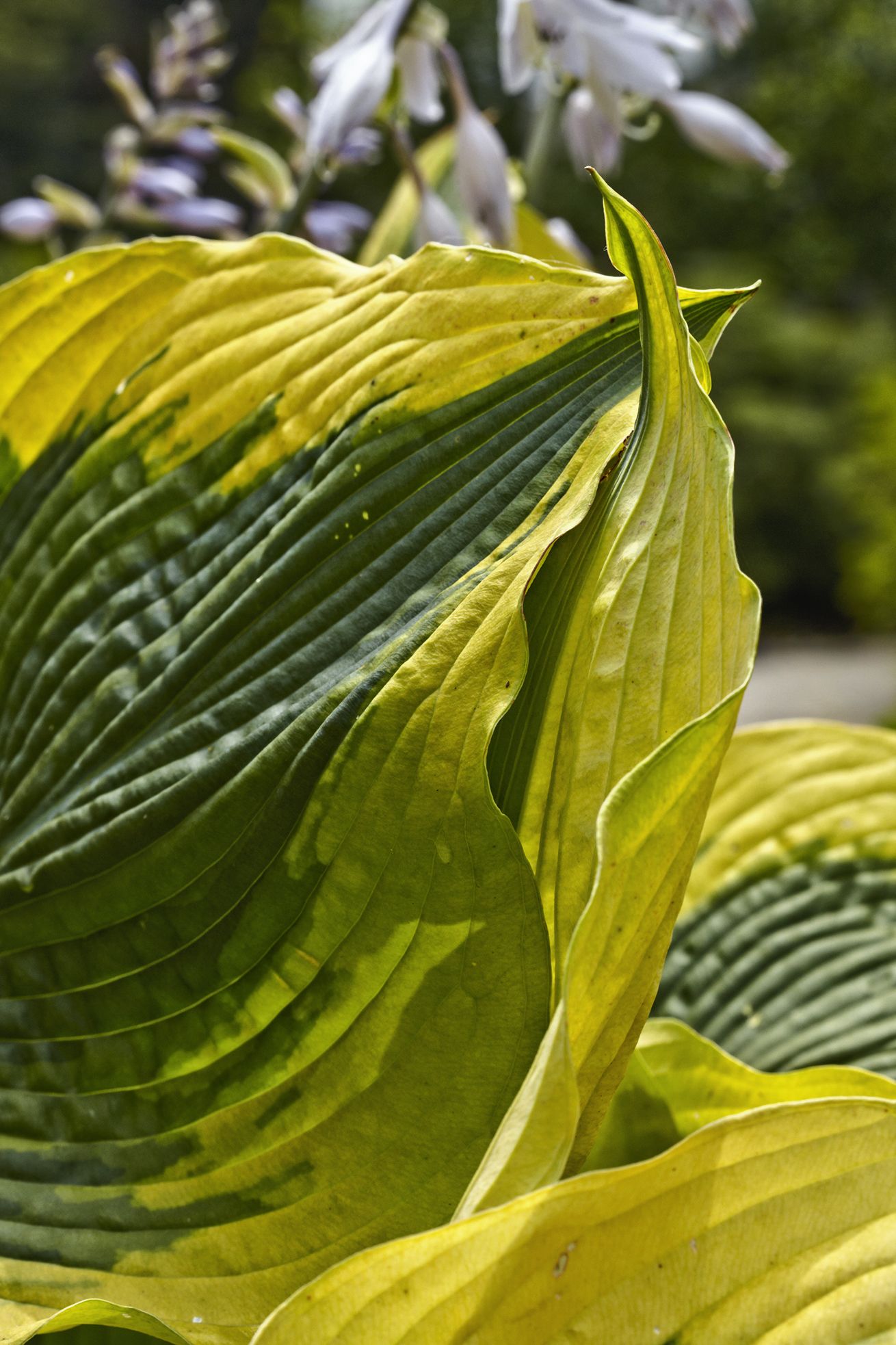
Hosta breeders continue to develop new varieties with unique textures, colors, and patterns. While we may not see entirely new core colors in the near future, recent introductions offer exciting variations on traditional hosta characteristics. These innovations broaden the gardener’s palette, creating more options for creative expression and landscaping possibilities.
Some noteworthy developments include red-stemmed varieties such as ‘Rocket’s Red Glare,’ which feature dark red stems that provide a striking contrast to their green foliage. Multicolor variegation is also on the rise, with varieties such as ‘Rare Breed’ showcasing three distinct colors on a single leaf, creating a more complex and visually interesting pattern. Changing colors bring more flair, with hostas such as ‘Autumn Frost’ starting with one color combination in spring and gradually changing throughout the season, offering a dynamic display. Glossy leaves, such as those on cultivars like ‘Irish Luck,’ feature a lacquer-like finish on their leaves, providing an interesting contrast to traditional matte varieties. These new variations allow gardeners to create even more diverse and visually appealing shade gardens, combining different textures, colors, and patterns for a truly unique landscape.
Shown: ‘Atlantis’ has yellow margins that get brighter with more sunlight.
Distinguished Hosta Varieties
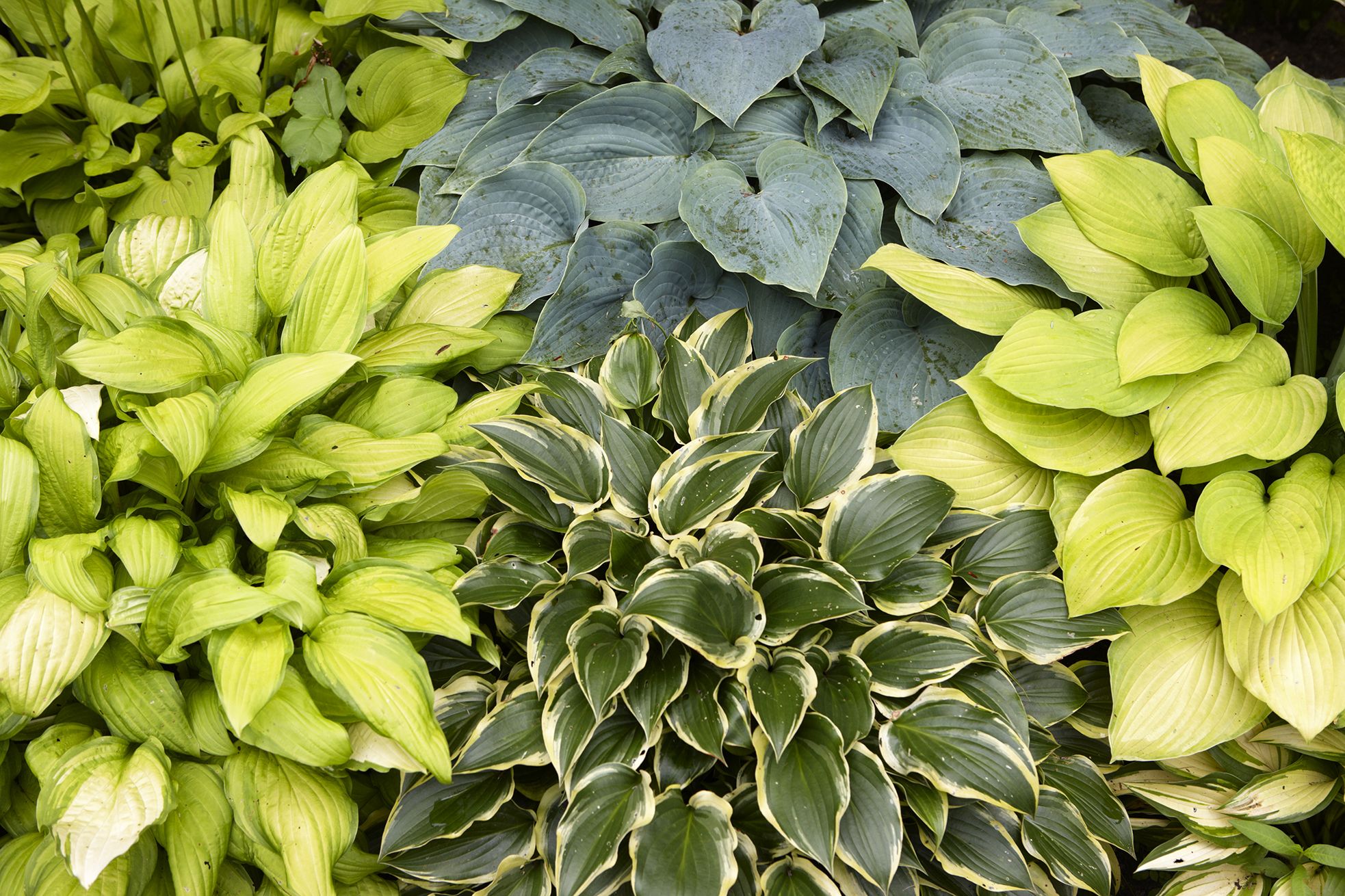
As hosta breeding continues to evolve, several distinguished varieties have emerged, offering improved characteristics and unique features. These varieties cater not only to visual appeal but also to practical gardening needs, providing both beauty and resilience.
‘Silver Bay’ is a blue hosta that maintains its color throughout the season, addressing a common challenge with blue varieties. ‘Blue Mouse Ears’ feature thick, rubbery blue-gray leaves that are naturally slug-resistant, making them a wise choice for gardens facing these pest challenges. ‘Sparkler’ showcases dark, heavy, almost dart-like green-and-white leaves with a unique shape, adding a dramatic flair. ‘Surfer Girl’ offers medium-green foliage with wavy, ruffled edges for added texture, while ‘Tropical Dancer’ features fluted, piecrust-shaped foliage with creamy-white margins and green centers. These distinguished varieties demonstrate the ongoing innovation in hosta breeding, providing gardeners with an ever-expanding palette of options for creating stunning shade gardens.
Shown: Planting with a hosta’s mature spread in mind makes for a bed that looks full but not overcrowded. Here, the chartreuse leaves of ‘Moon Lily’ (right) and ‘Peedee Gold Flash’ are picked up in the margins of ‘Sundance’ (far left).
Showstopping Hosta Plants
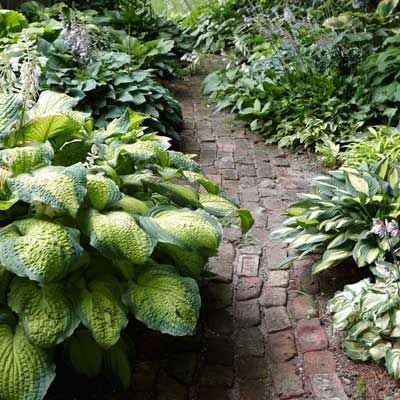
Using mostly solid-green and solid-blue varieties as a foundation can establish a cohesive backdrop. Incorporate simple variegated hostas that repeat the colors of nearby solid varieties to achieve visual continuity. Vary the width of leaf margins on variegated hostas to add visual interest and complexity. Group brighter gold and chartreuse hostas together for a striking impact that draws the eye. Use smaller, brightly colored or variegated varieties in greater numbers among larger, muted hostas to provide contrast and embellishment. By following these guidelines, you can create a cohesive and visually striking shade garden that showcases the beauty and diversity of hostas.
Shown: By repeating colors, you draw the eye through a garden. Here, the yellow and green of large-leaved ‘Summer Serenade’ (left) are echoed in the smaller ‘T-Dawg’ opposite it.
Little Care, Lots of Payoff
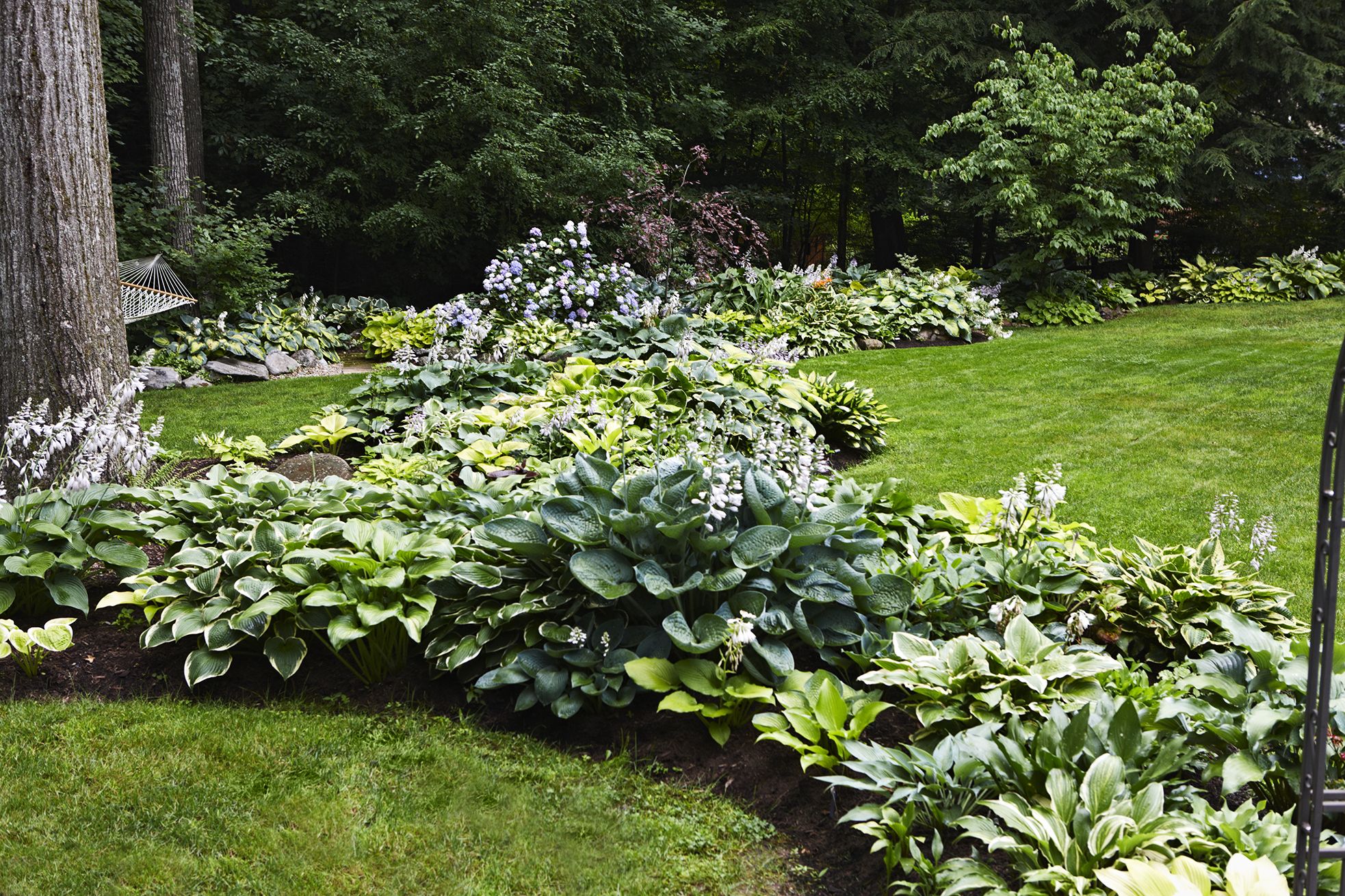
One of the most appealing aspects of hostas is their low-maintenance nature. Once established, these hardy perennials require minimal care while providing years of beauty and interest to your garden. They’re ideally suited for gardeners seeking a balance between prolific foliage and straightforward upkeep.
To make sure your hostas thrive, water consistently, especially during dry spells, to maintain their lush appearance. Apply a layer of organic mulch to retain moisture and suppress weeds. Fertilize annually in spring with a balanced, slow-release fertilizer to support robust growth. Divide hostas every three to five years to maintain vigor and propagate new plants. Hostas pair well with other shade-loving plants, such as astilbe, oakleaf hydrangea, phlox, iris, and clematis. Their large leaves can also help conceal the fading foliage of spring-blooming bulbs, making them excellent companions in mixed borders.
Shown: In curving rows, hostas create natural-looking, low-maintenance borders for a large expanse of lawn without hardscape edging. Here, they divide the turf into different outdoor rooms, adding to the feeling of a green oasis.
River of Hosta Foliage
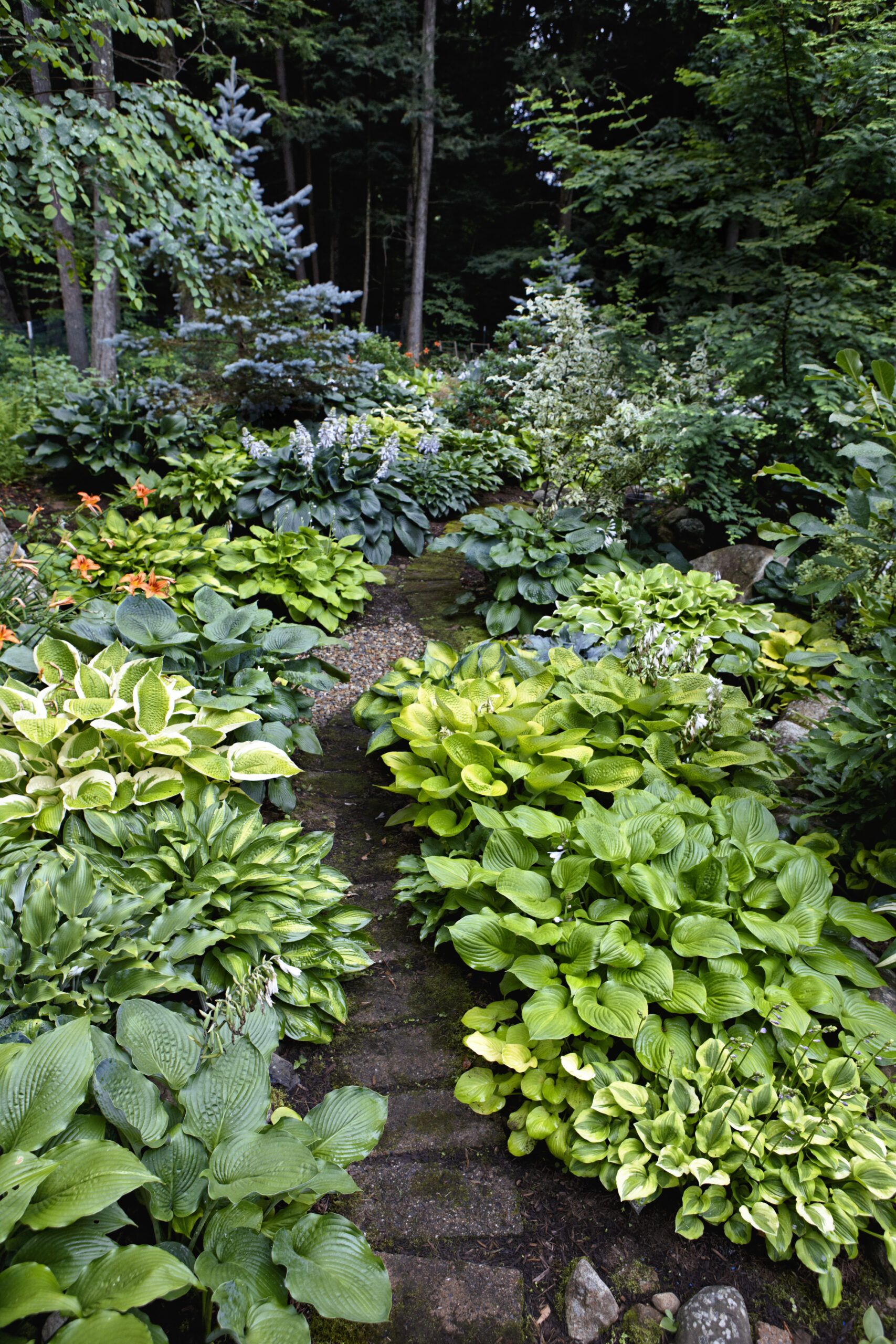
Creating a “river of foliage” using hostas is an excellent way to add visual interest and flow to your shade garden. This design technique involves planting hostas in long, curved swaths that mimic the natural curves of a river, making use of these plants’ diverse forms and textures.
To achieve this effect, choose a variety of hosta sizes, colors, and textures to create depth and variety within the river. Plant larger varieties toward the back and smaller ones in front for a more structured, layered appearance. Use repetition of colors and shapes to create a sense of fluid movement. Incorporate contrasting foliage plants to add depth and interest to this undulating plant tapestry. This technique is particularly effective along woodland paths or as a border for larger garden beds.
A Pop of Blue and Lavender
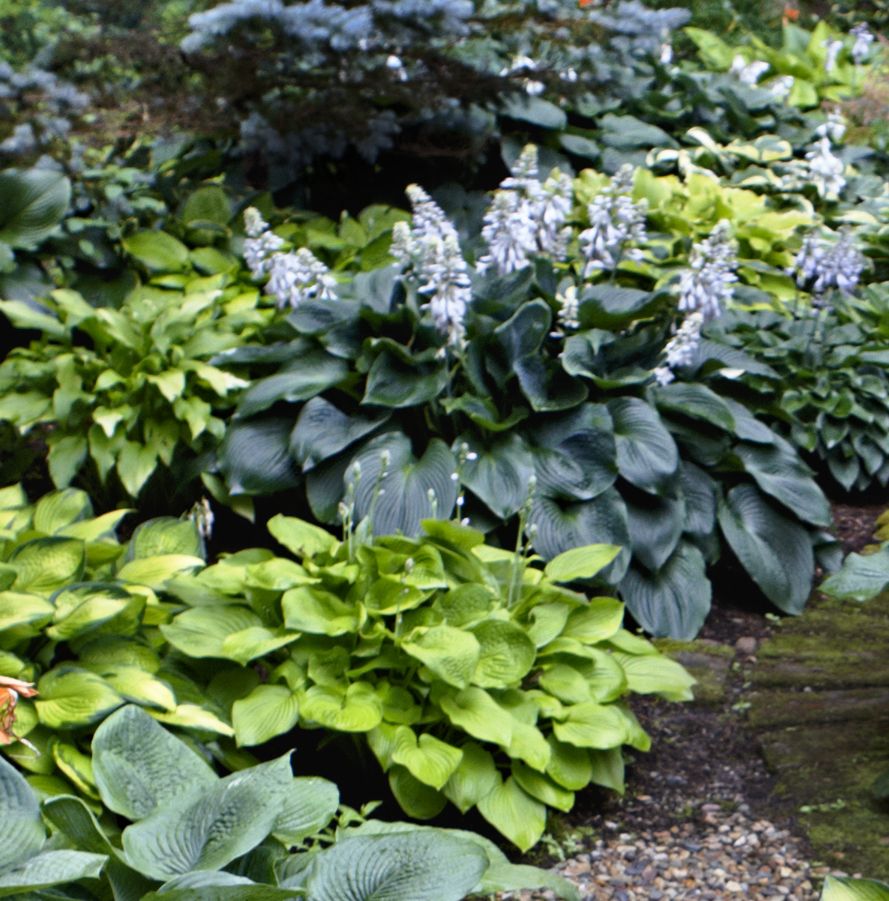
‘Blue Angel’
Alluring Fragrance
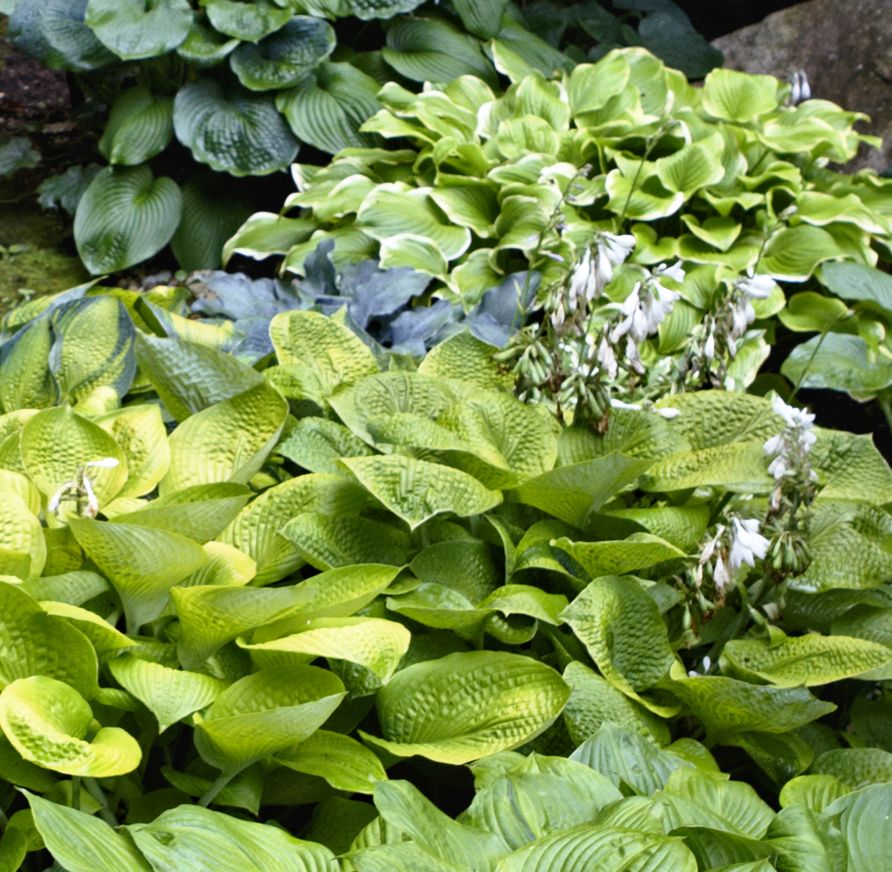
‘Fragrant Bouquet’
Glossy, Vibrant Color
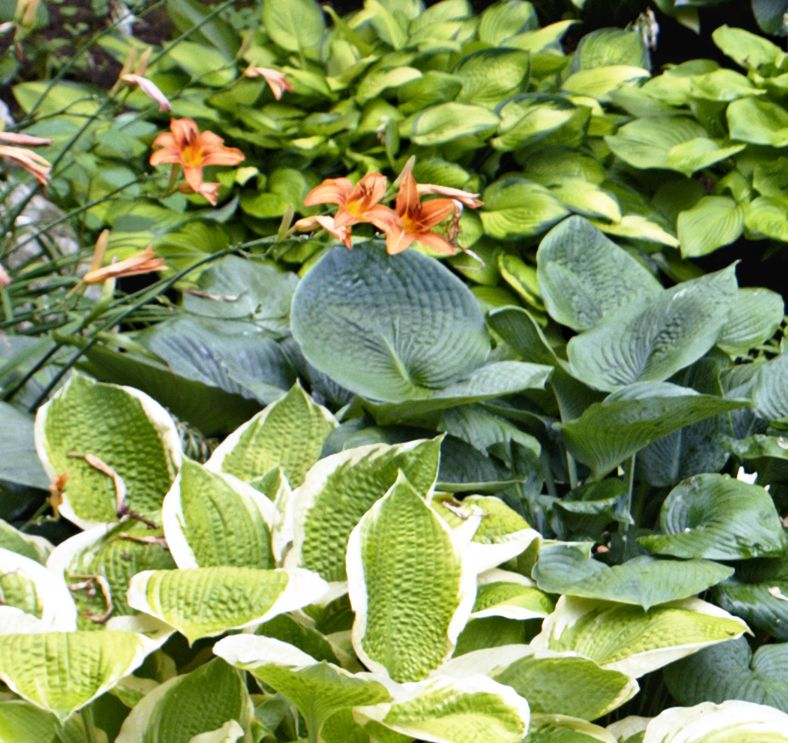
‘Super Bowl’
Blue-Green Margins
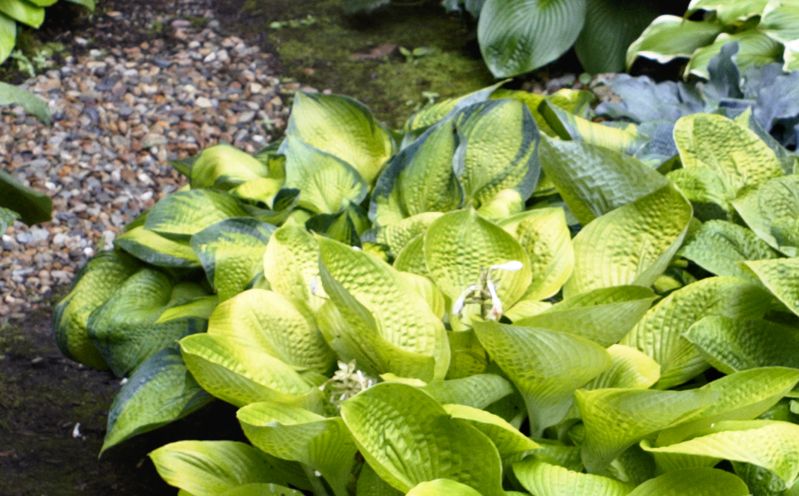
‘Bright Lights’
Lots of Texture
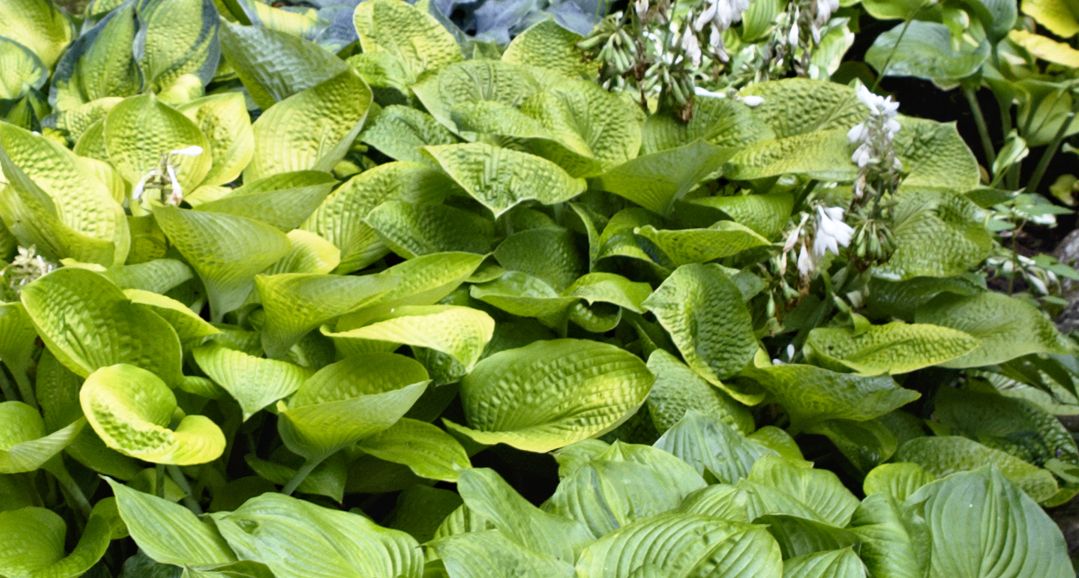
‘Aspen Gold’
Colorful Name, Colorful Leaves
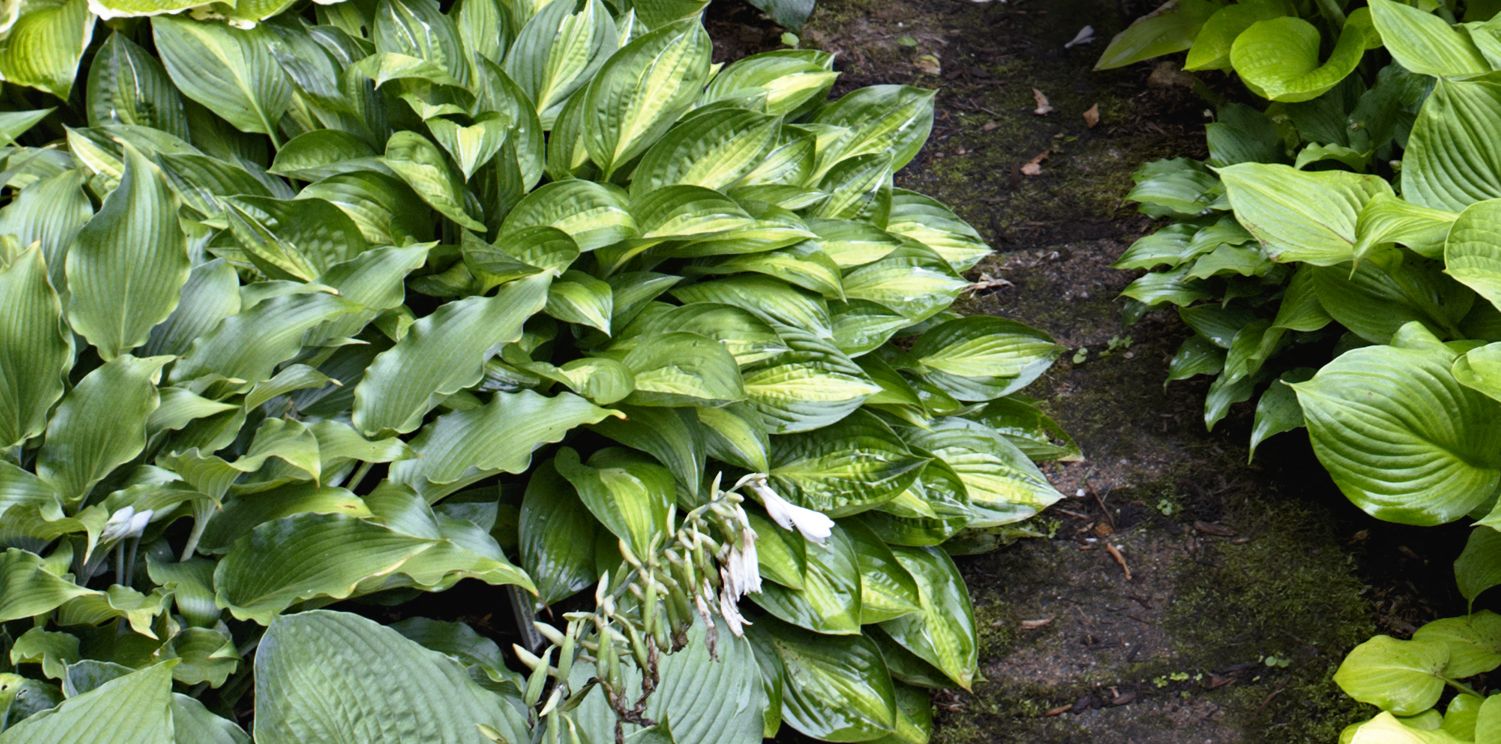
‘Yellow Polka Dot Bikini’
Rippled Edges
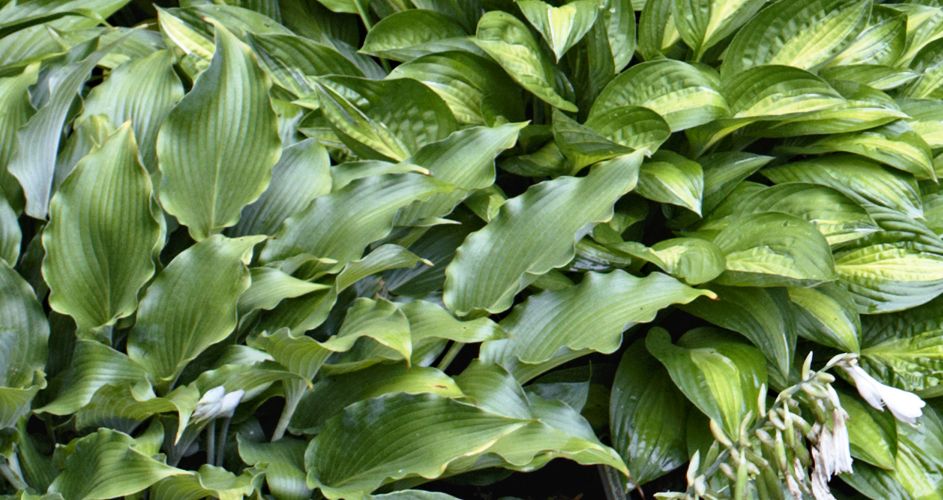
‘Elvis Lives’
Luscious Leaves
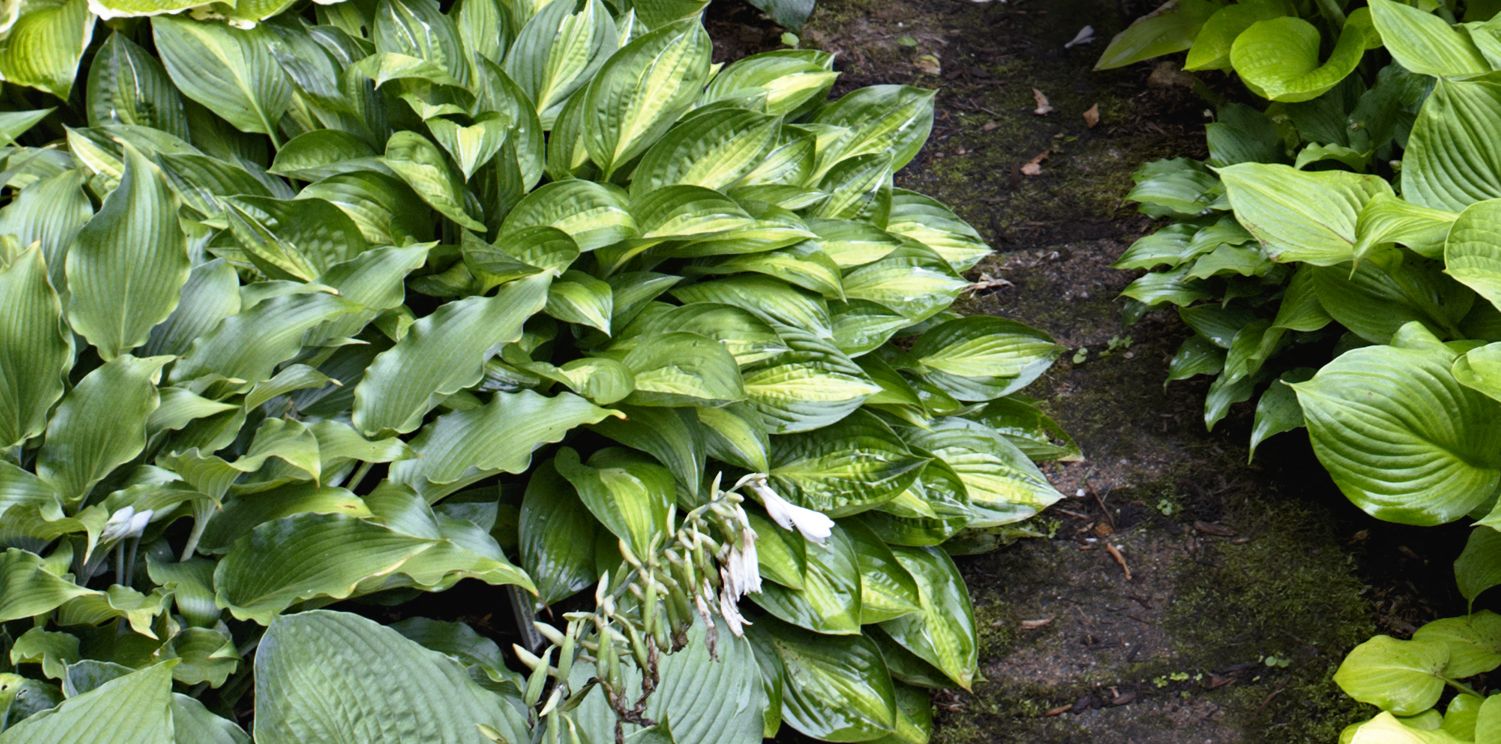
‘Autumn Haze’
A Little Extra Texture
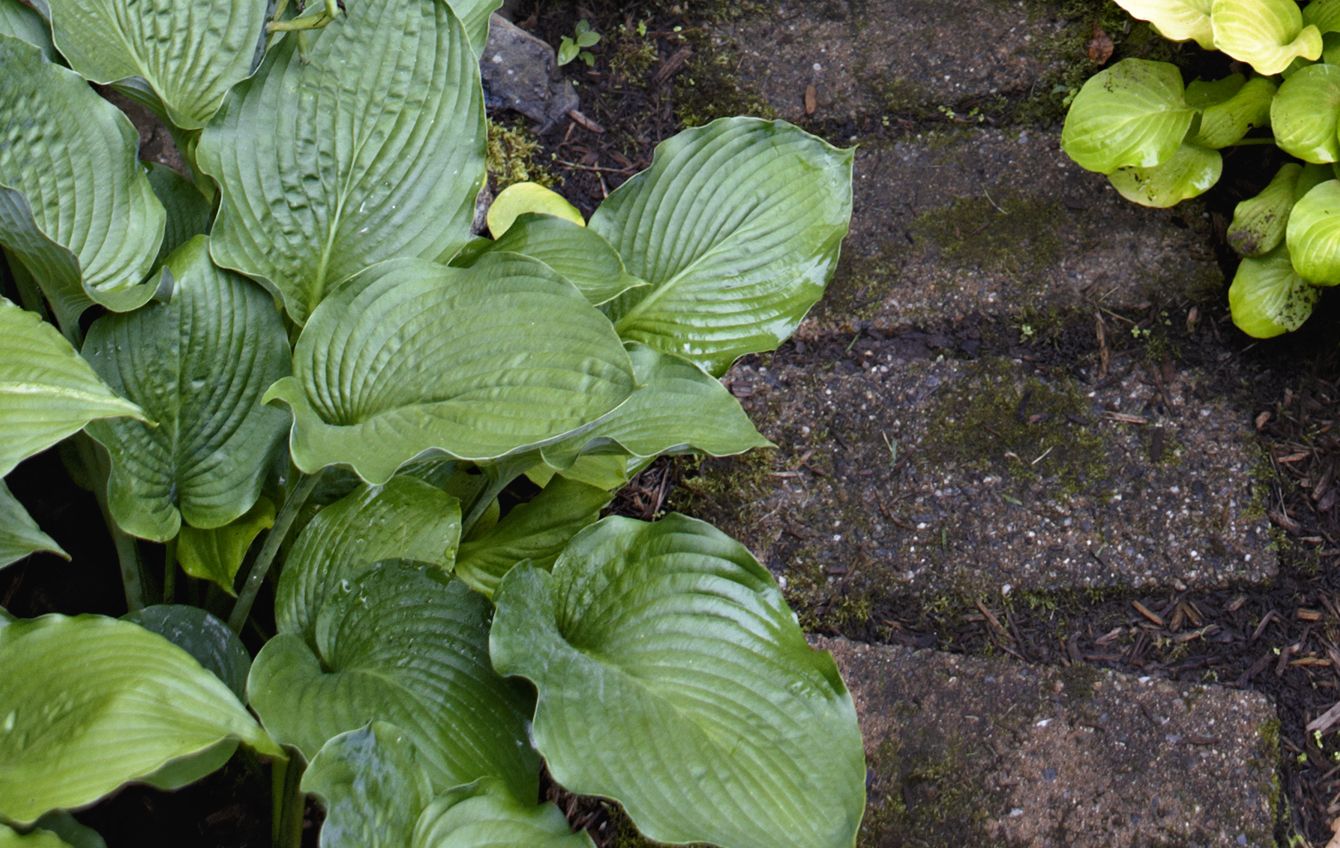
‘Reptilian’
Framed Green
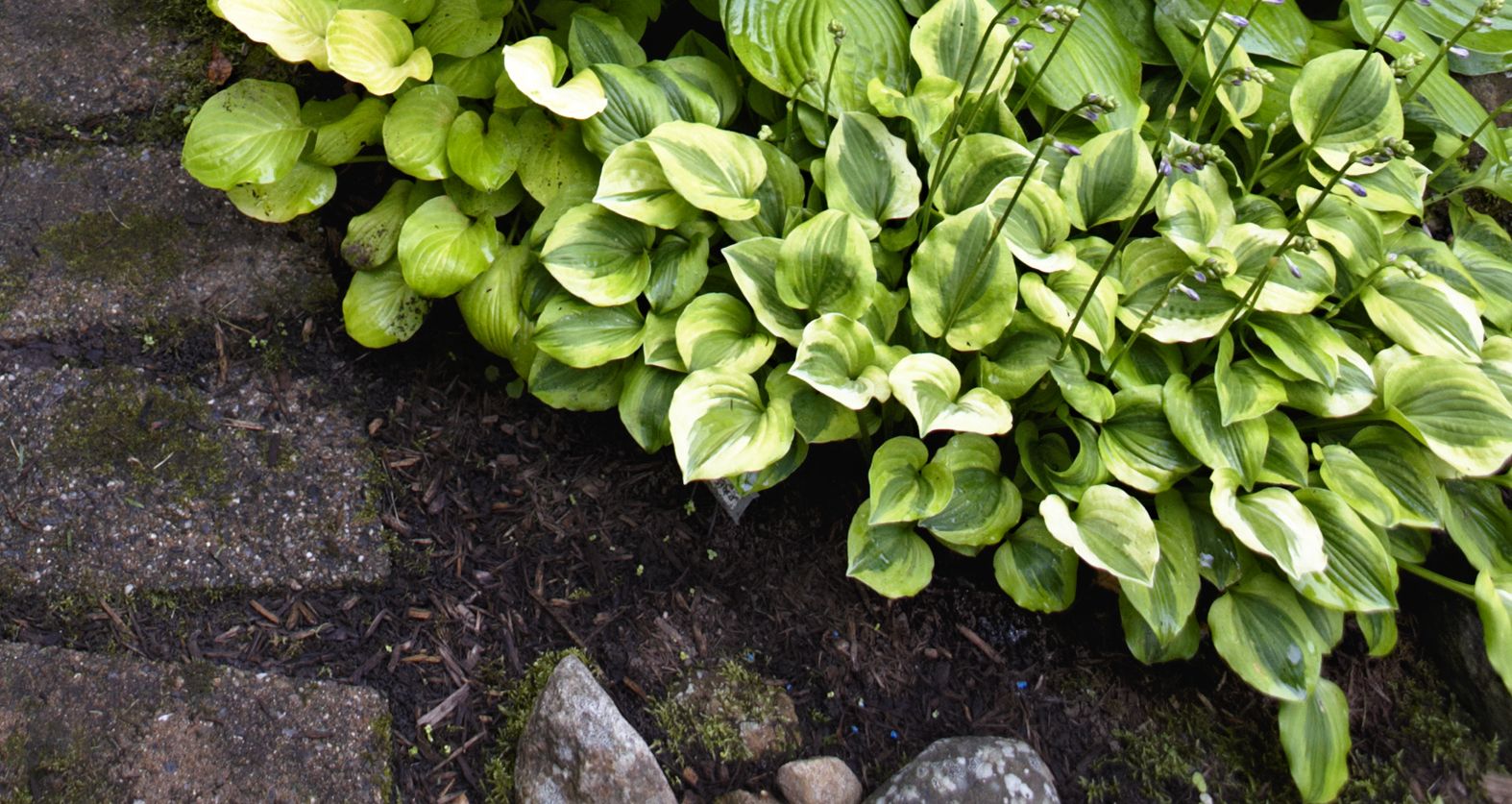
‘Grand Tiara’
Stark Color Contrast
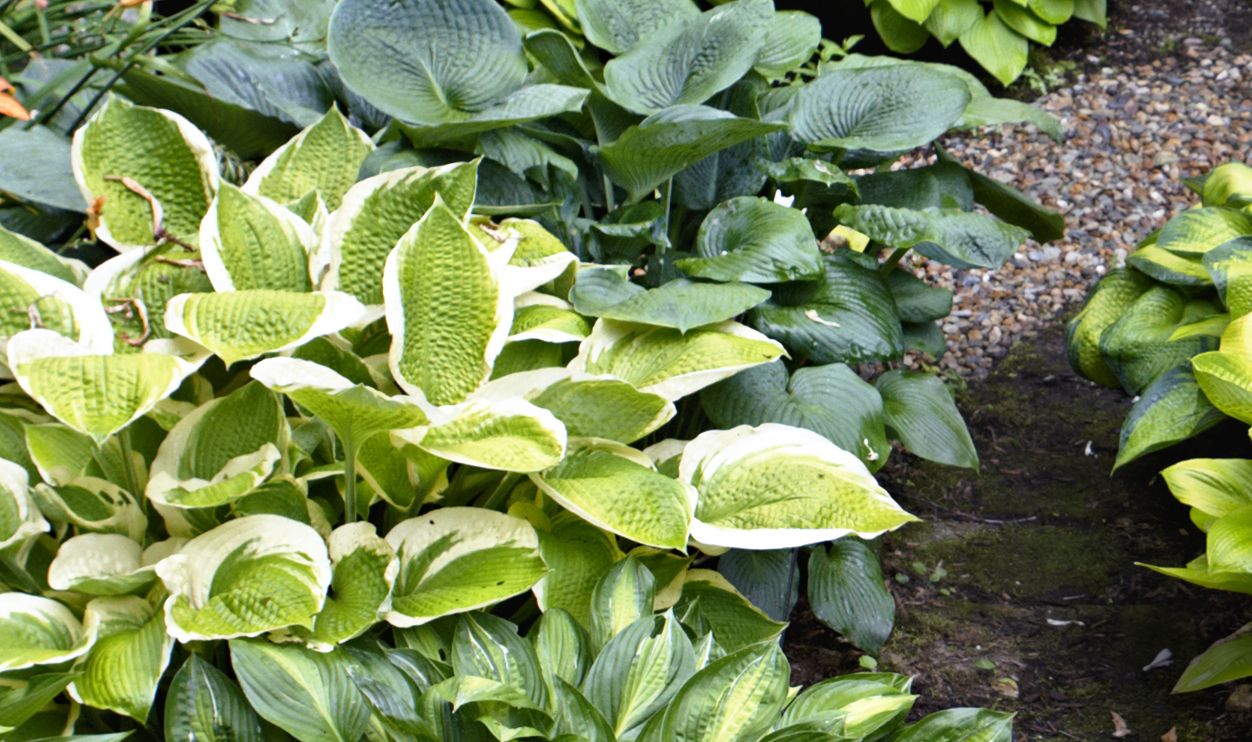
‘Sunshine Glory’
Colorful Companions
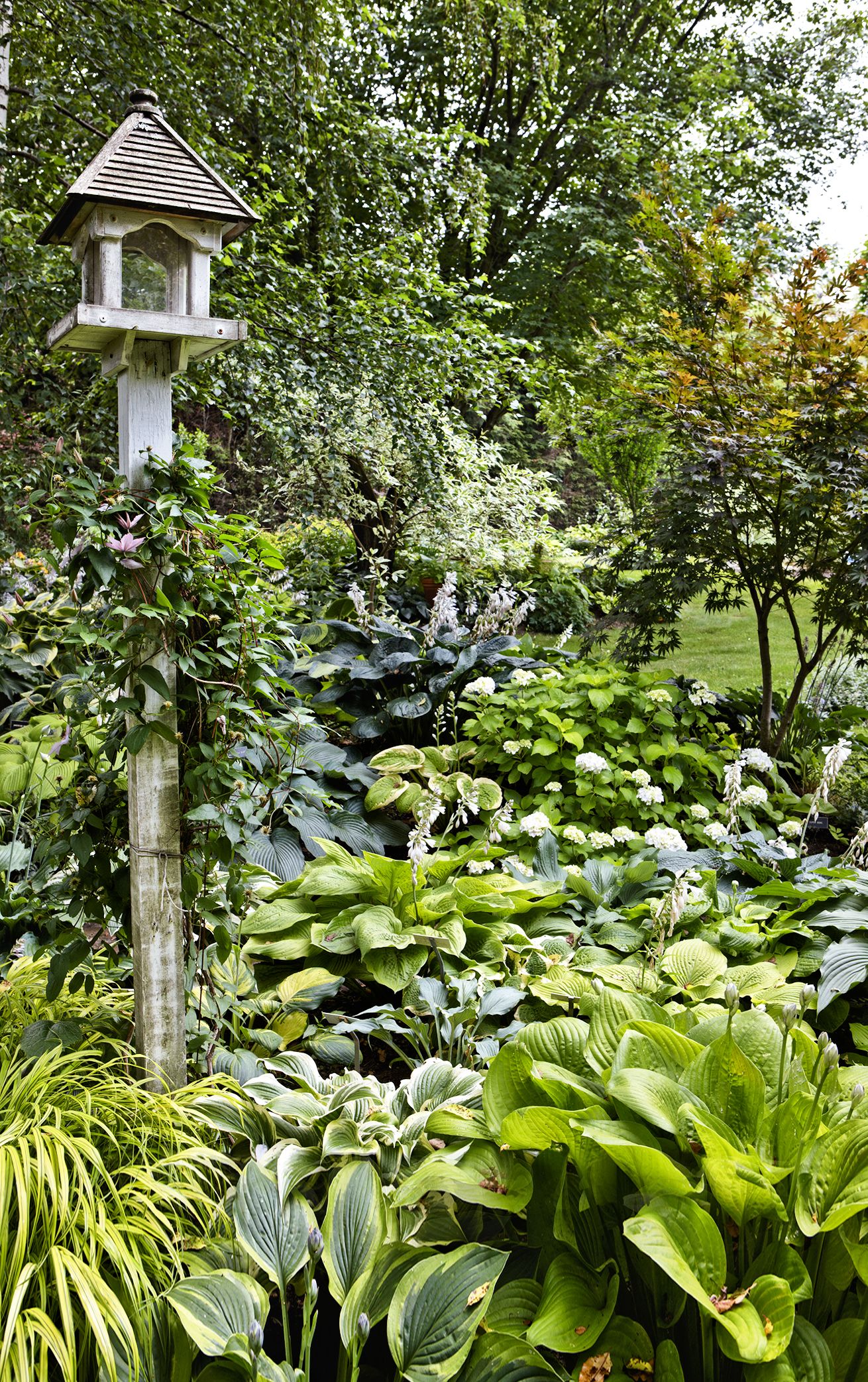
Pairing hostas with complementary plants can create stunning visual displays in your shade garden. Use the following combinations: Blue-green hostas with blue mophead hydrangeas present a cool, soothing palette. Variegated hostas with Japanese forest grass offer contrasting textures, improving visual complexity. Green hostas paired with pink or purple flowering plants such as astilbe or columbine provide vibrant color contrasts. Gold hostas with ferns create a bright woodland feel, invoking the tranquility of a forest setting. Remember to gauge the mature size and growth habits of companion plants to make sure they don’t overshadow or compete with your hostas.
The Hosta Color Spectrum
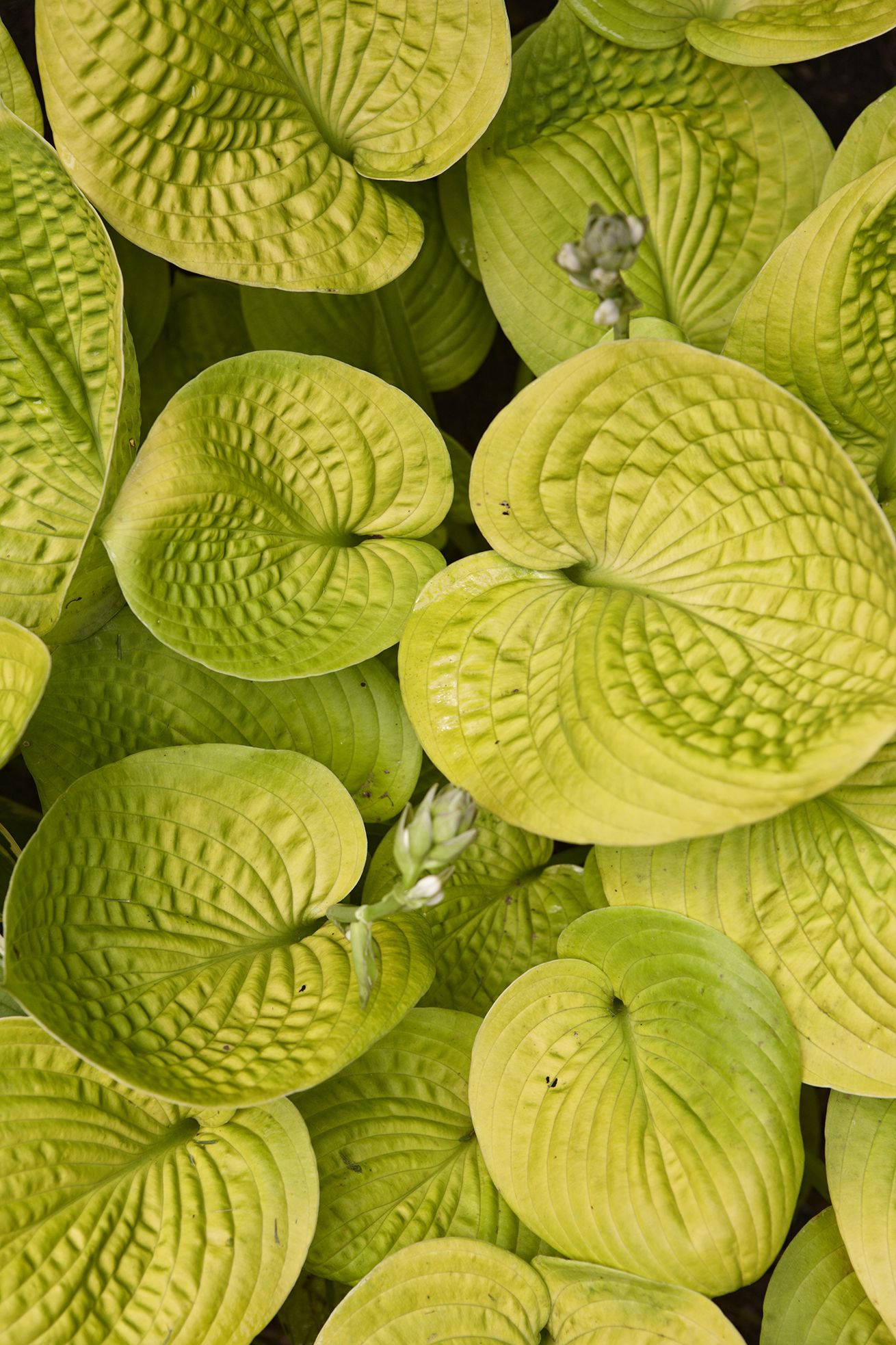
The thousands of different named hostas are variations on three main colors: green, blue, and gold. Variegation can be found in every combination of these colors, as well as with white.
‘Maui buttercups’
Jetting Ivory Margins
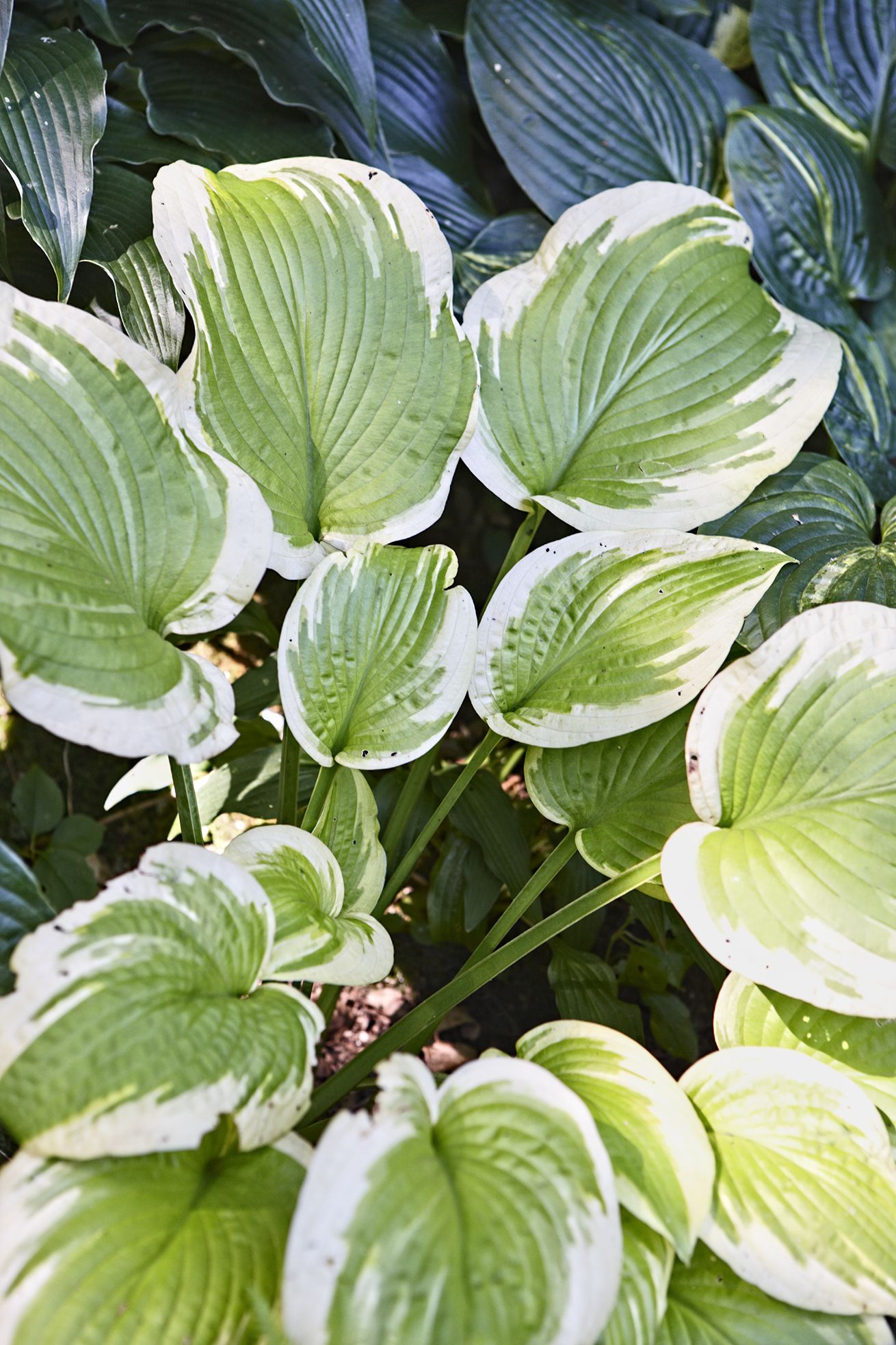
‘Delta dawn’
Green Seersucker and Lavender
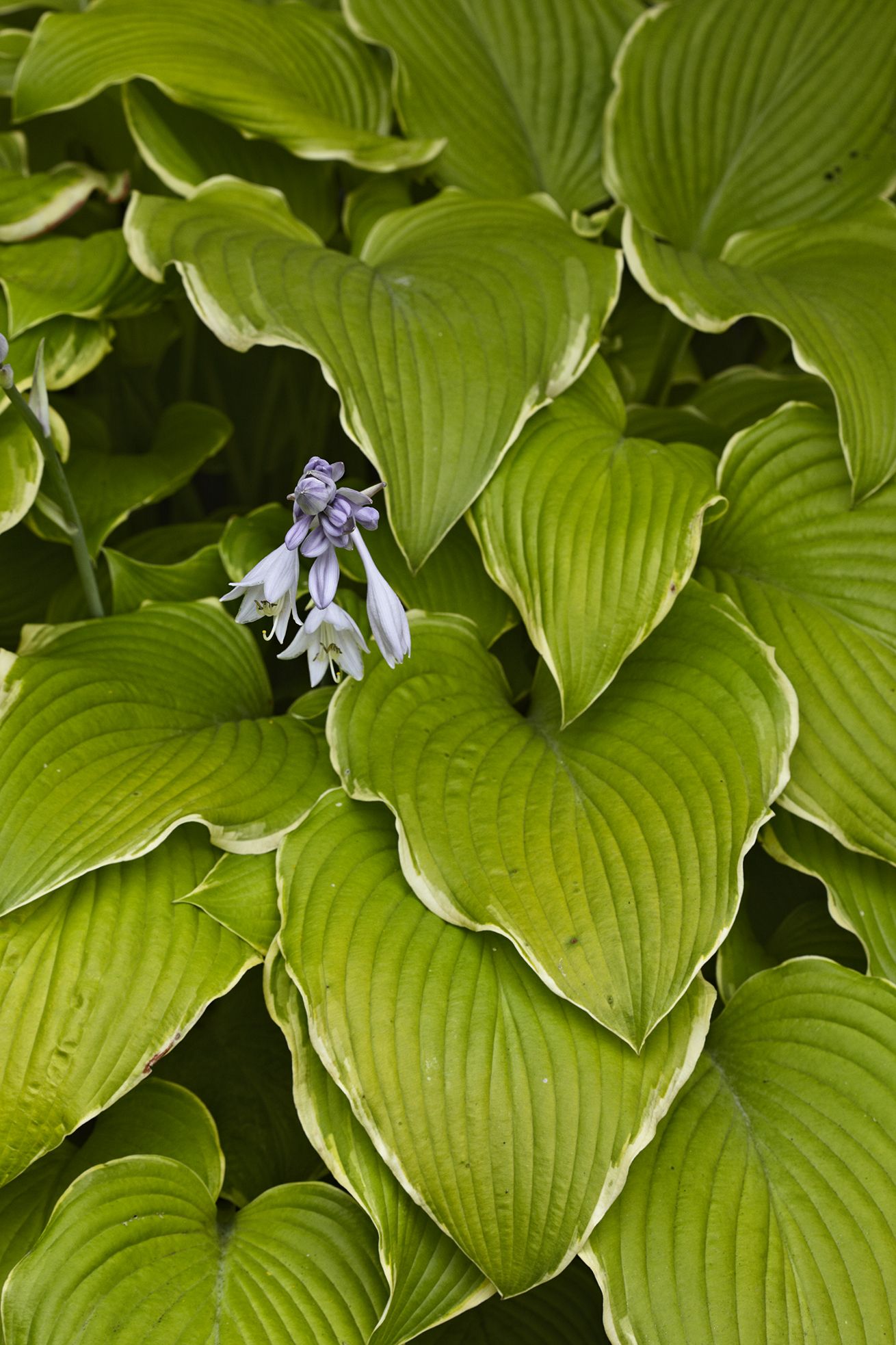
‘Lakeside cha cha’
Deep Blue Ruffles

‘Cutting edge’
Divide Hosta Plants to Share: Step 1
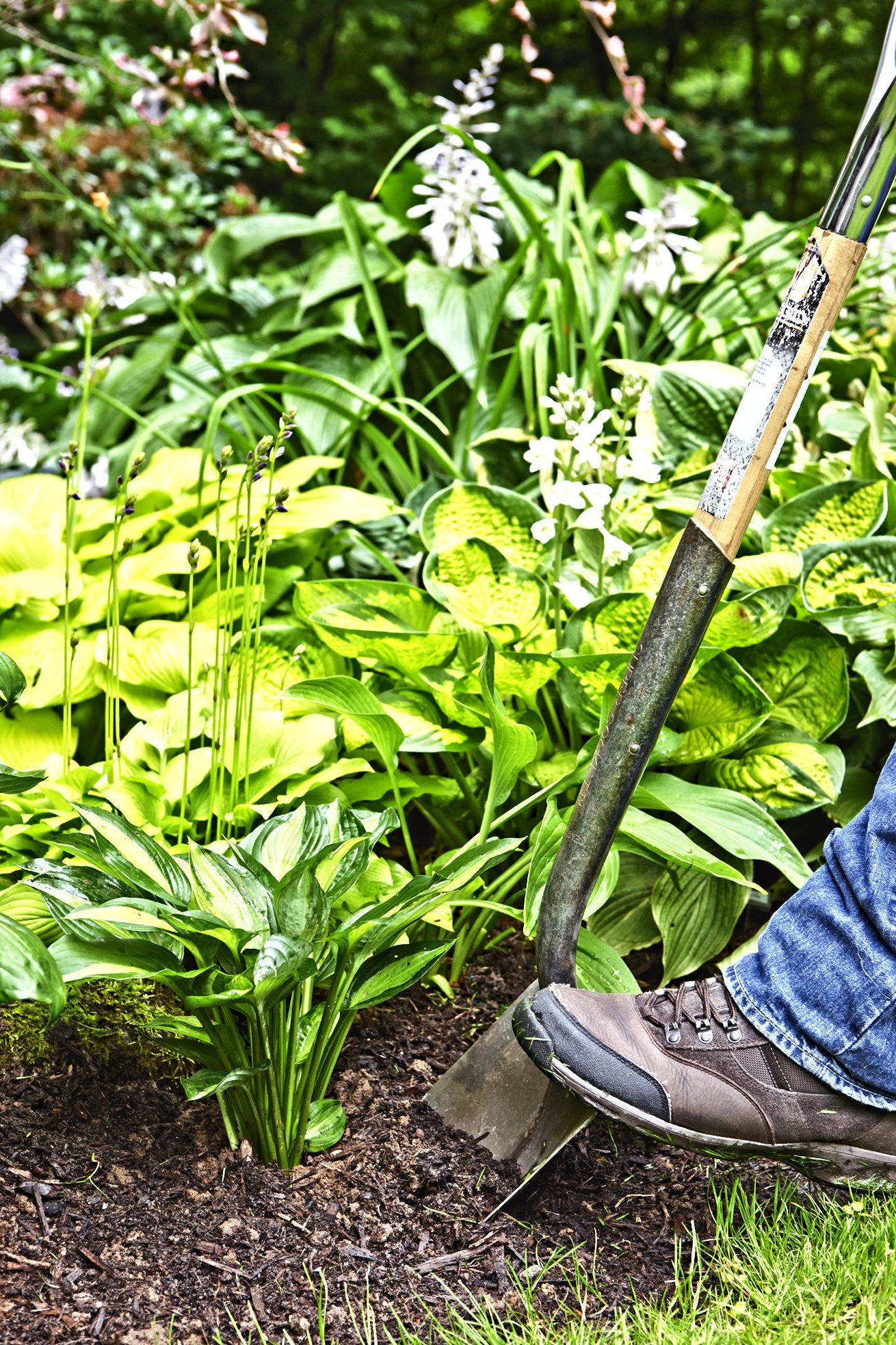
Splitting hostas every two to three years is a great way to multiply your riches and present them as gifts to gardening friends and neighbors.
Using a spade shovel, dig along the plant’s drip line and remove the root ball.
Divide Hosta Plants to Share: Step 2
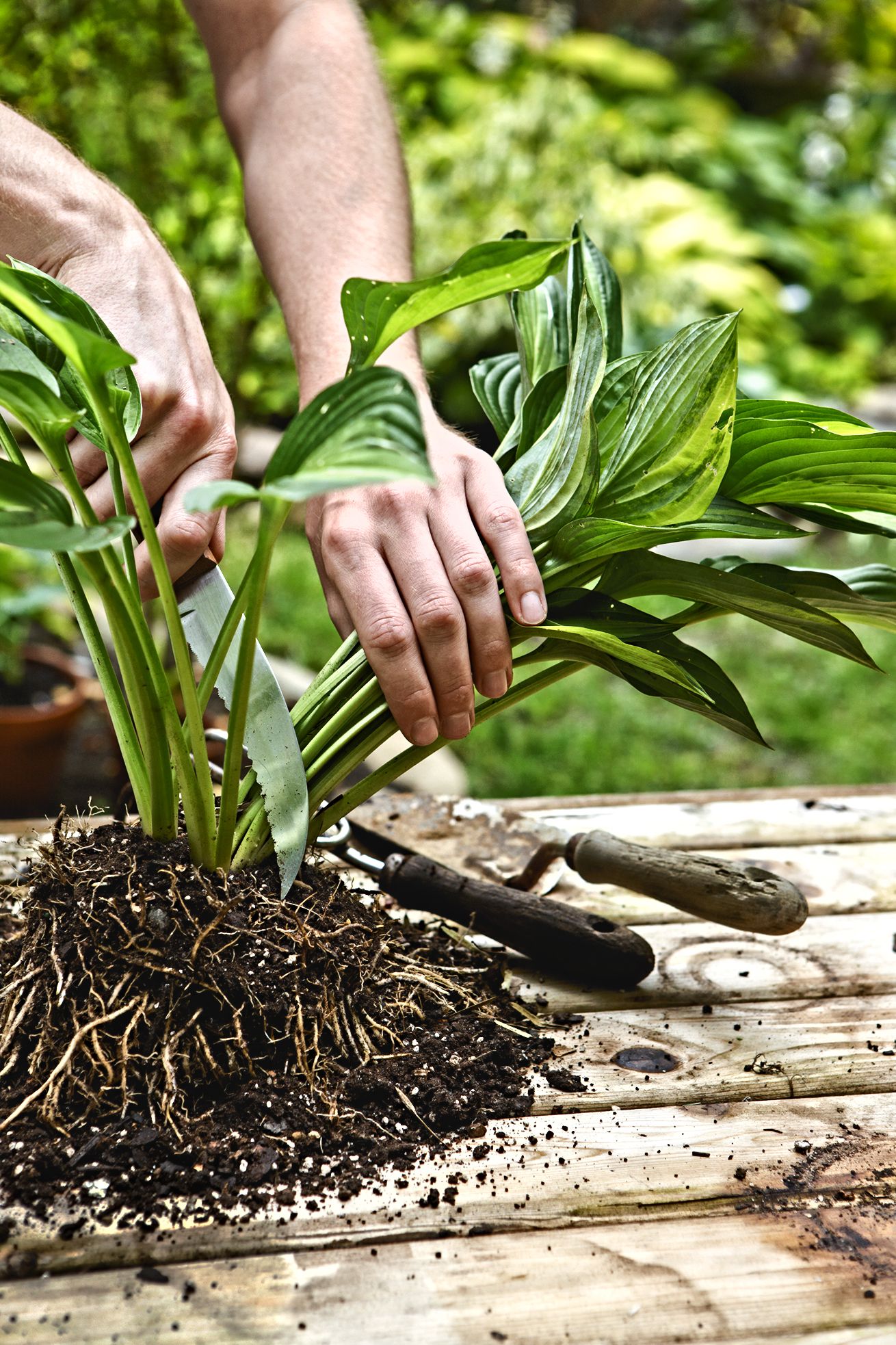
Shake off excess soil and place the plant on a work surface; separate the leaves to find the center of the crown, pulling the stems into groups of at least three.
Divide Hosta Plants to Share: Step 3
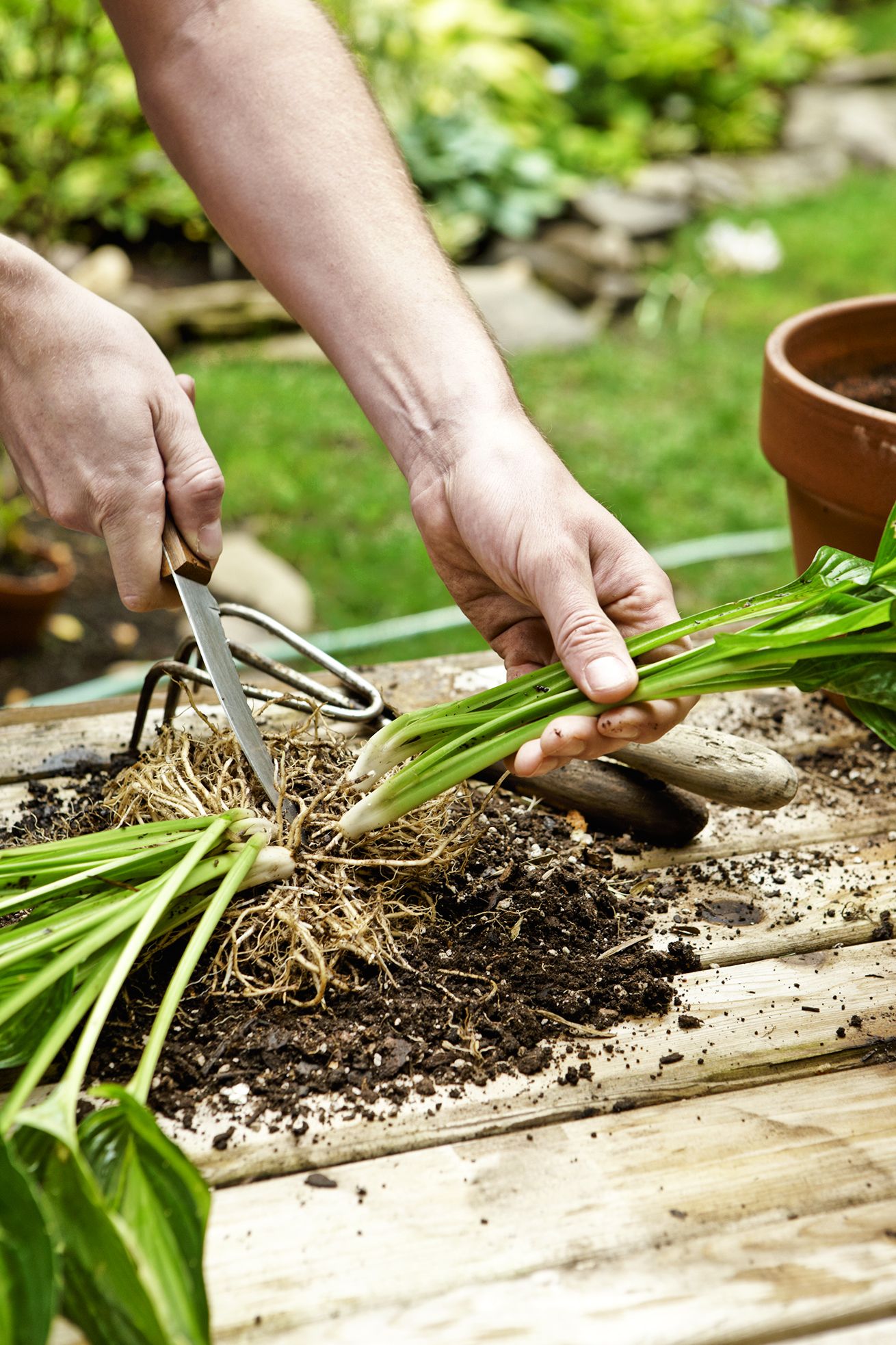
Using a soil knife, cut through the crown while gently pulling away a section as you cut.
Divide Hosta Plants to Share: Step 4
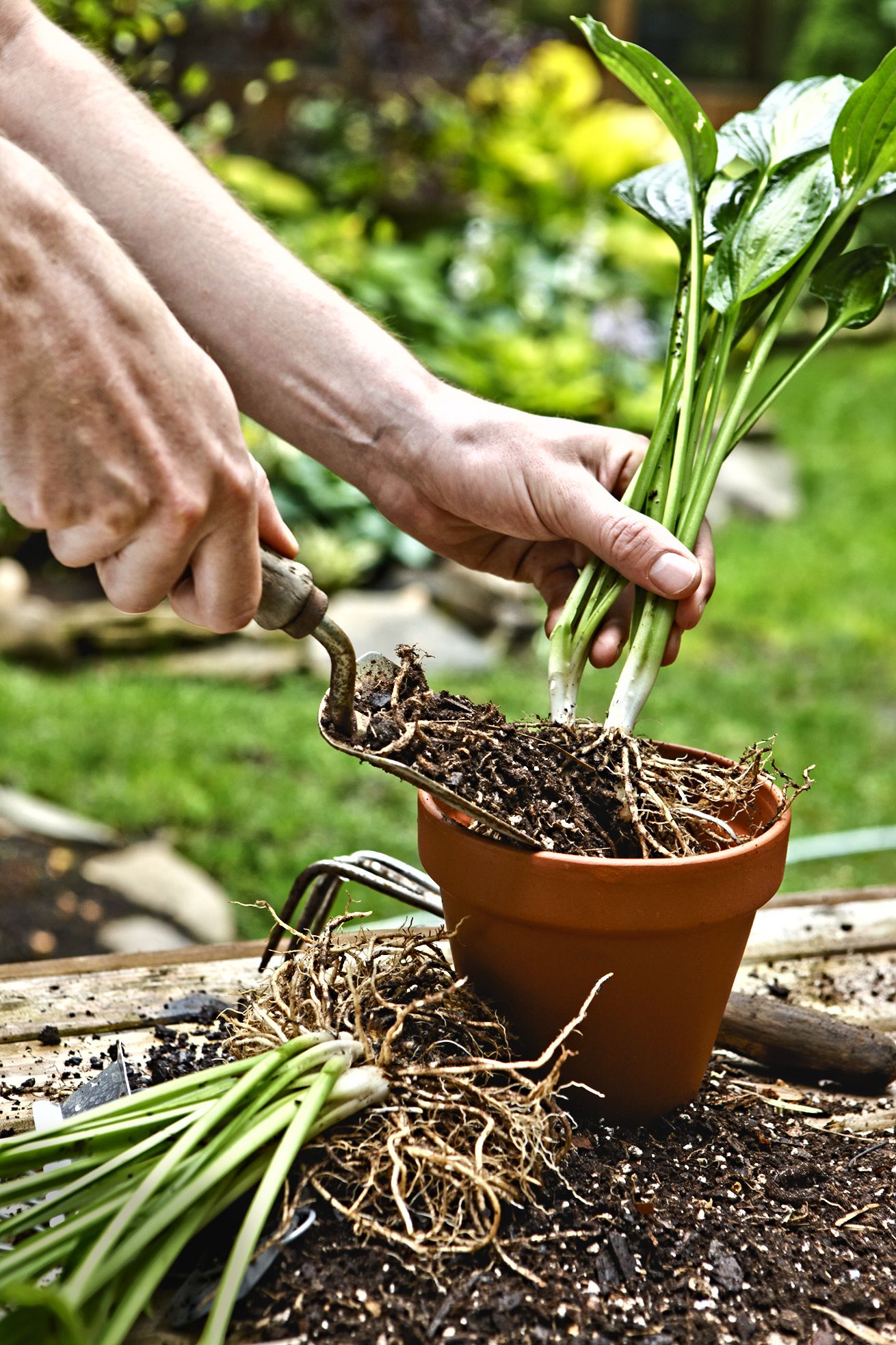
Pot up the divisions in a mix of compost and soil and keep them moist until you can replant them.
Protect Hostas Against Vole Damage: Step 1
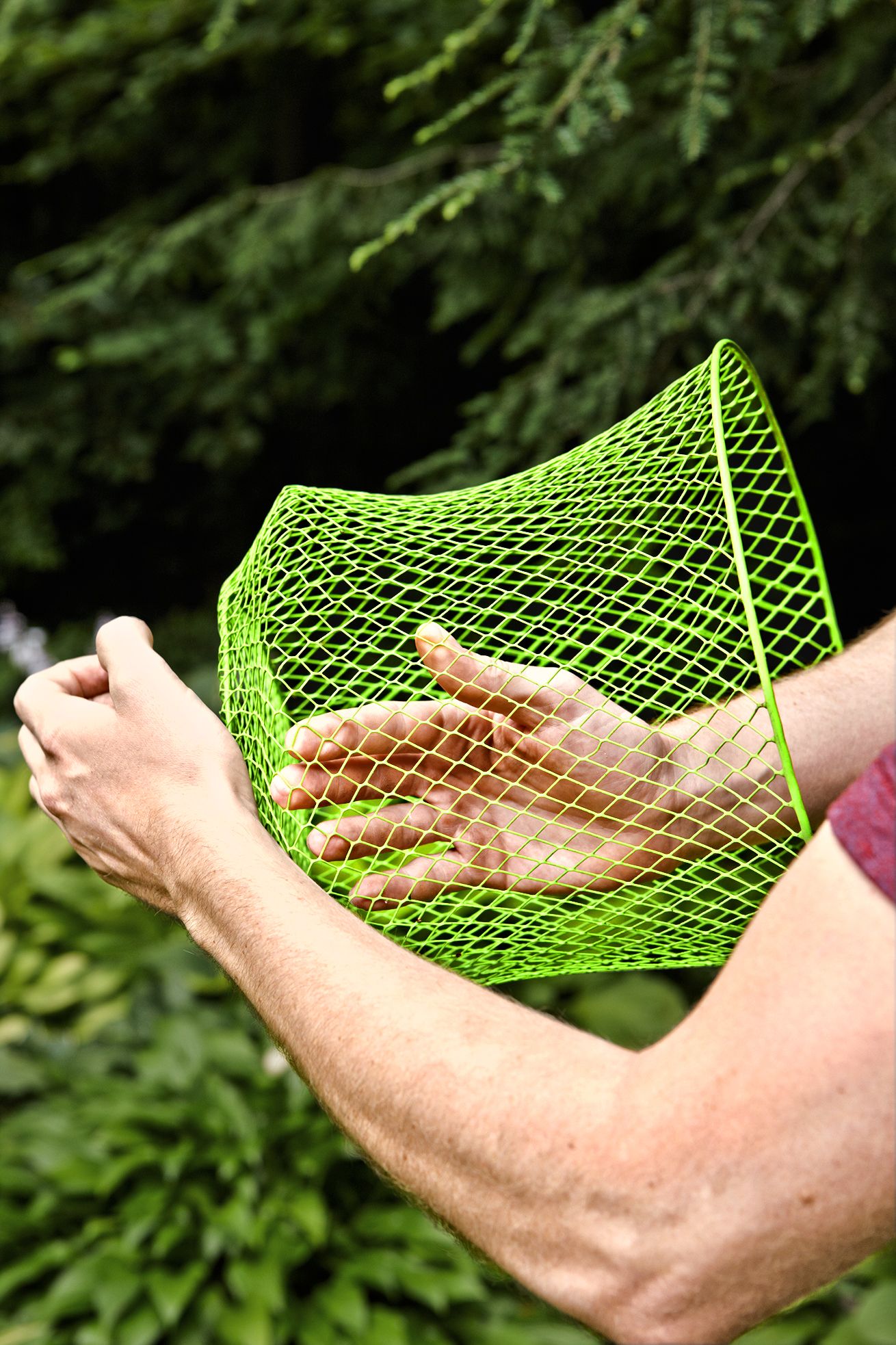
In most areas of the country, you can find voles roaming gardens, tunneling within the top 9 inches of soil to look for grubs and plants to snack on. Hostas, with their thick, fleshy roots, are a favorite. Stymie these garden invaders with a physical barrier, such as the modified 10-inch-diameter coated-wire-mesh wastepaper basket shown below. An inexpensive basket like this one protects all but the biggest hostas, for which you can craft a custom basket from hardware cloth. With the rim sitting just above the soil, the mesh protects the root ball while giving the roots room to grow. Once a vole bumps into the mesh, it will go around the basket, as it would a rock or tree root.
Here’s how to modify a mesh basket like the one shown:
Mark a line 10 inches down from the rim of the container; make a crease along this line by pressing the wire out with one hand inside the basket while pressing the bottom of the basket with the other hand.
Protect Hostas Against Vole Damage: Step 2
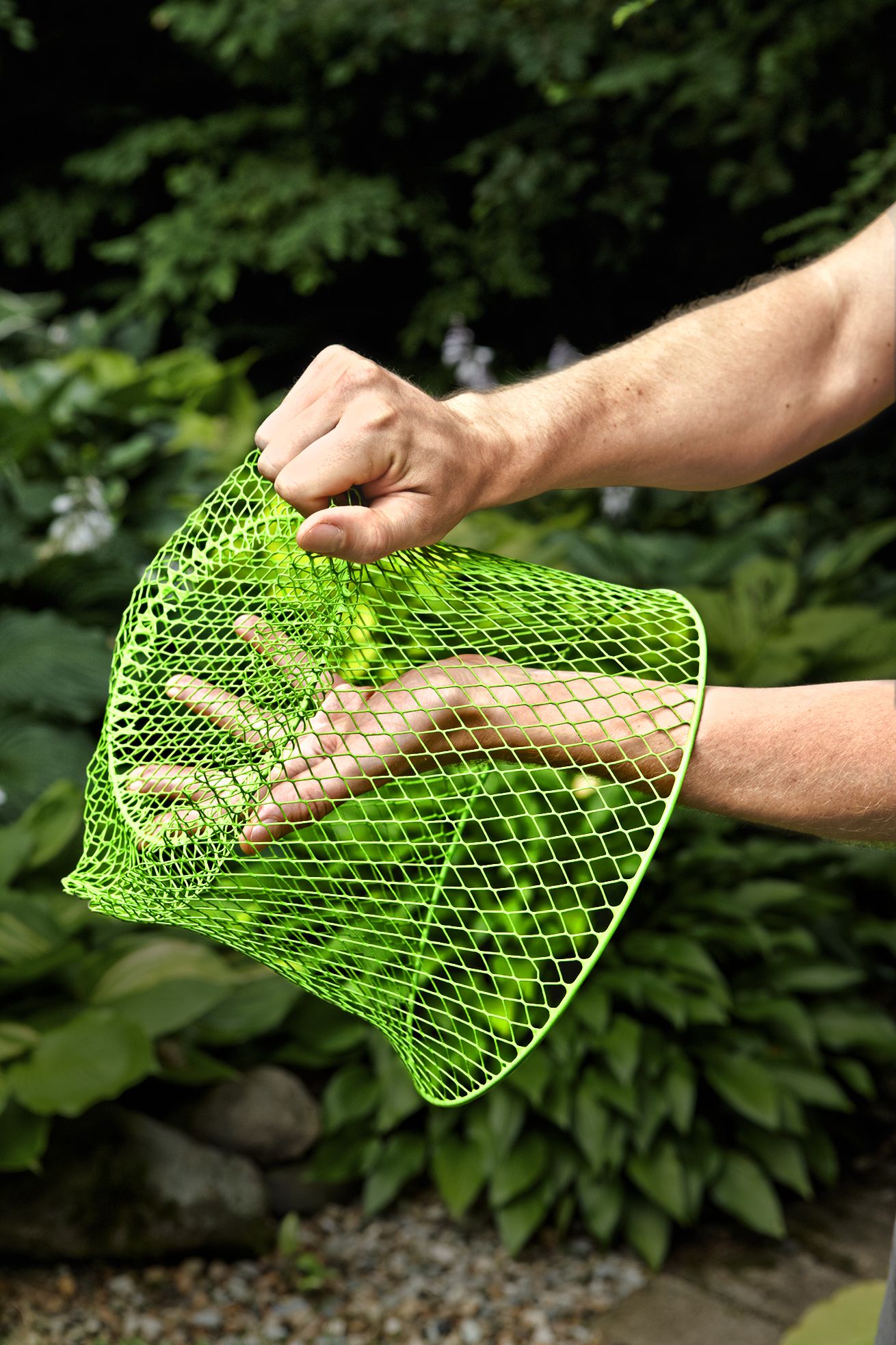
Crimp the crease together in line with the rim.
Protect Hostas Against Vole Damage: Step 3
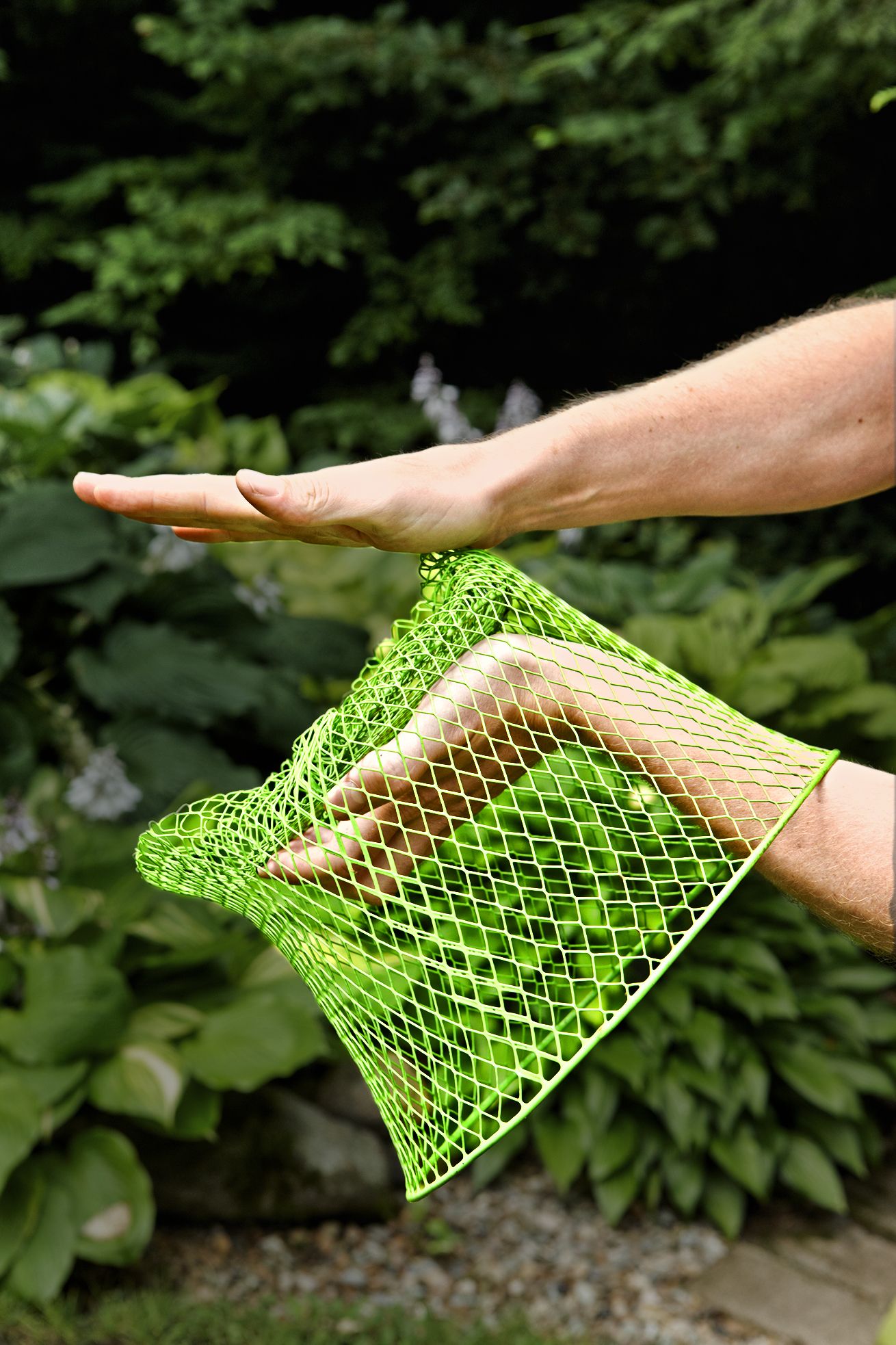
Using the heels of your hands, fold the crimped edge over toward the center, flattening the bottom.
Protect Hostas Against Vole Damage: Step 4
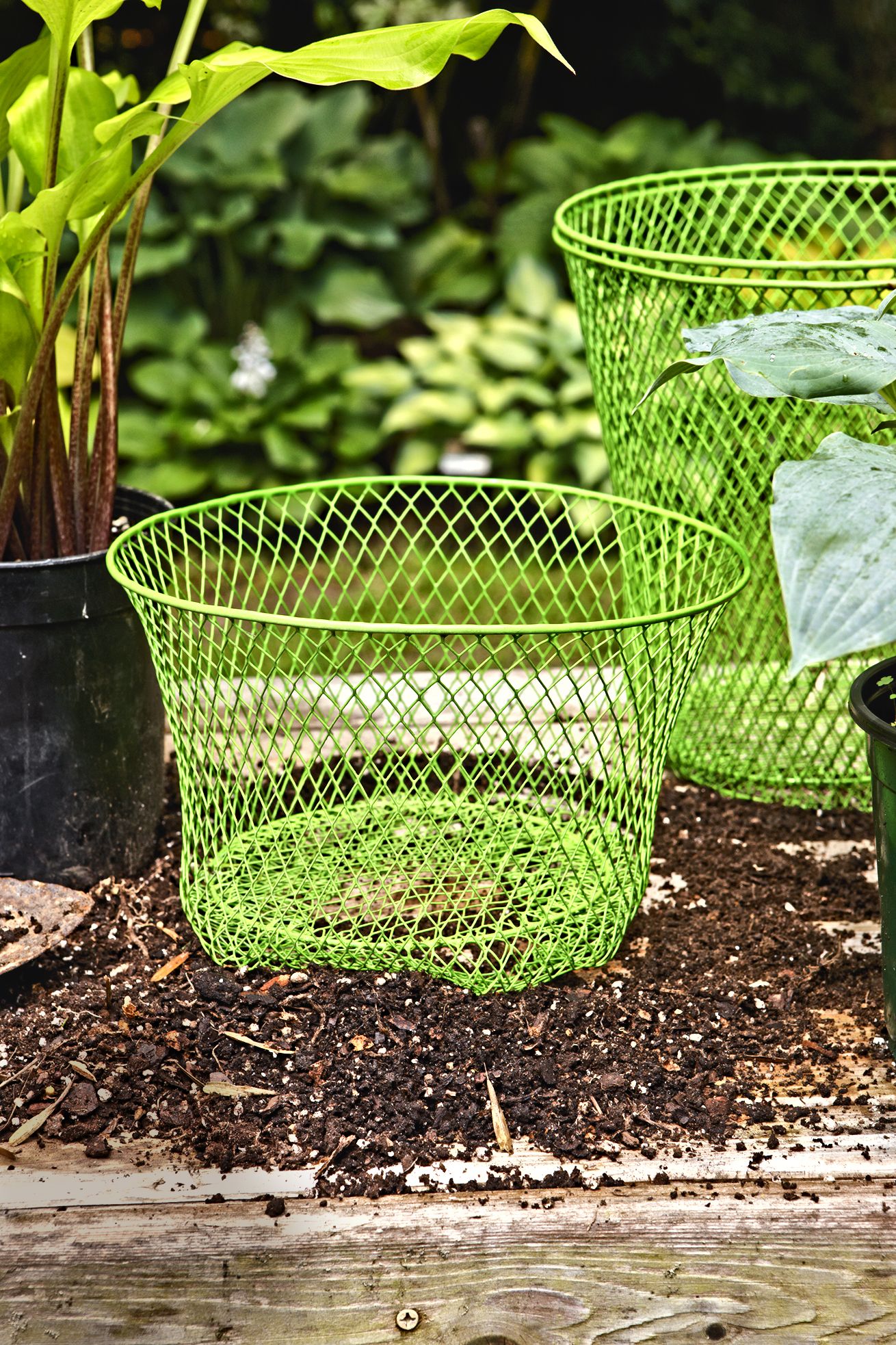
You should end up with a finished basket that’s about 10 inches tall; it can be spray-painted brown or black to blend in. Fill the basket with loamy soil, plant the hosta in the center, and pack down the soil around the root ball to collapse air pockets.
Protect Hostas Against Vole Damage: Step 5
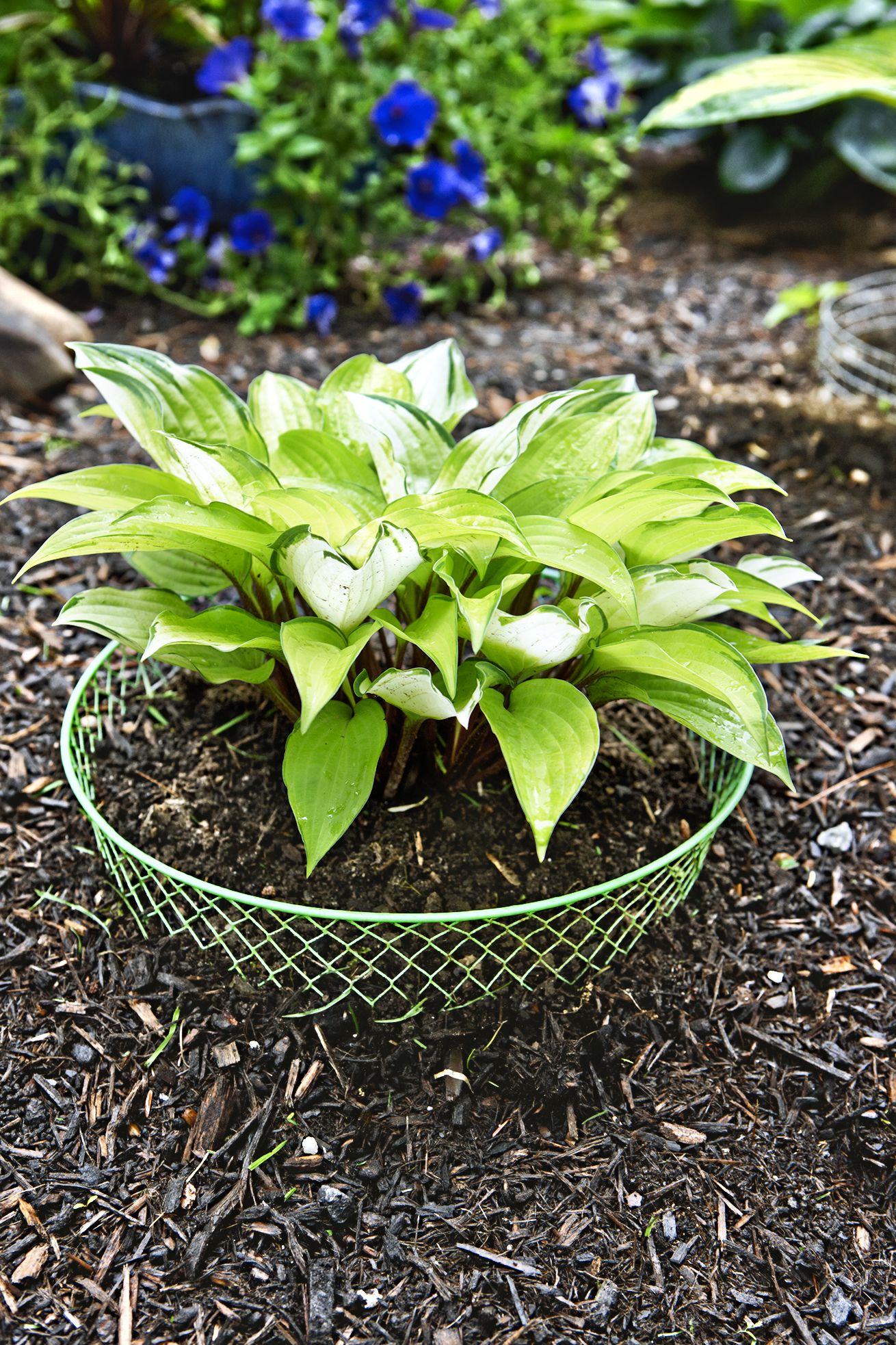
Dig a hole and place the hosta in the ground so that about 1 inch of the rim rests above grade; as the plant matures, leaves will cover the basket. Or hide the rim now with a 1-inch layer of mulch.
Where To Find Unusual Hosta Varieties
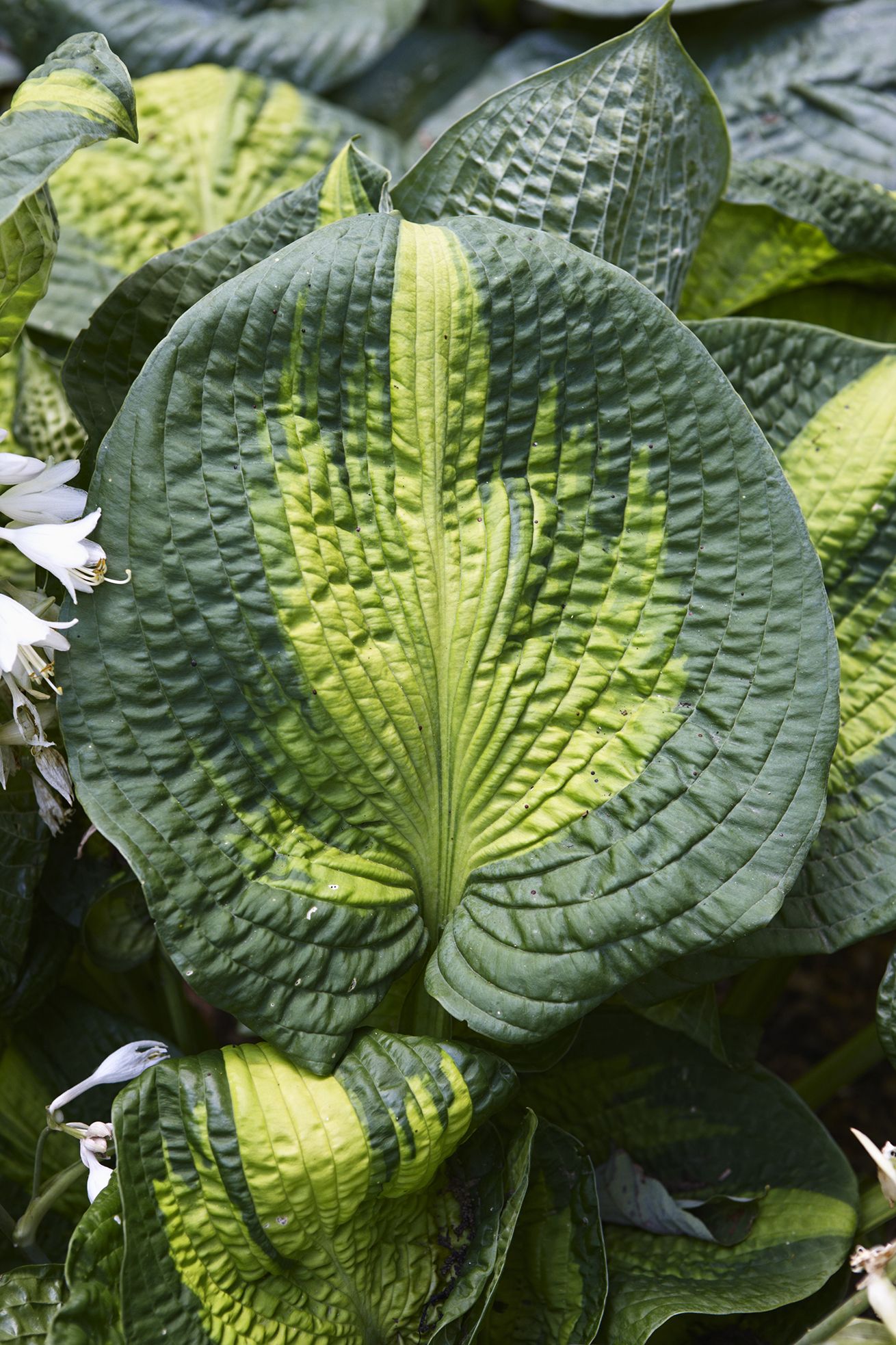
For gardeners seeking unique or rare hosta varieties, several specialized nurseries offer extensive collections. Land of the Giants Hosta Farm features over 21,000 varieties, including rare and unusual cultivars, providing a vast selection for those eager to explore diverse options. Naylor Creek offers nearly 900 hosta varieties, with a focus on newer introductions to keep your garden fresh and captivating. Perennial Nursery specializes in smaller and miniature hostas, perfect for container gardens or tight spaces where elegance is key. Plant Delights Nursery is known for its curated selection of high-quality, unique hostas ideal for connoisseurs looking for exceptional specimens. When purchasing hostas online, be sure to research the seller’s reputation and shipping practices to make sure you receive healthy, well-established plants ready to thrive in your garden.
Color and Texture for Even the Shadiest Corners of Your Yard
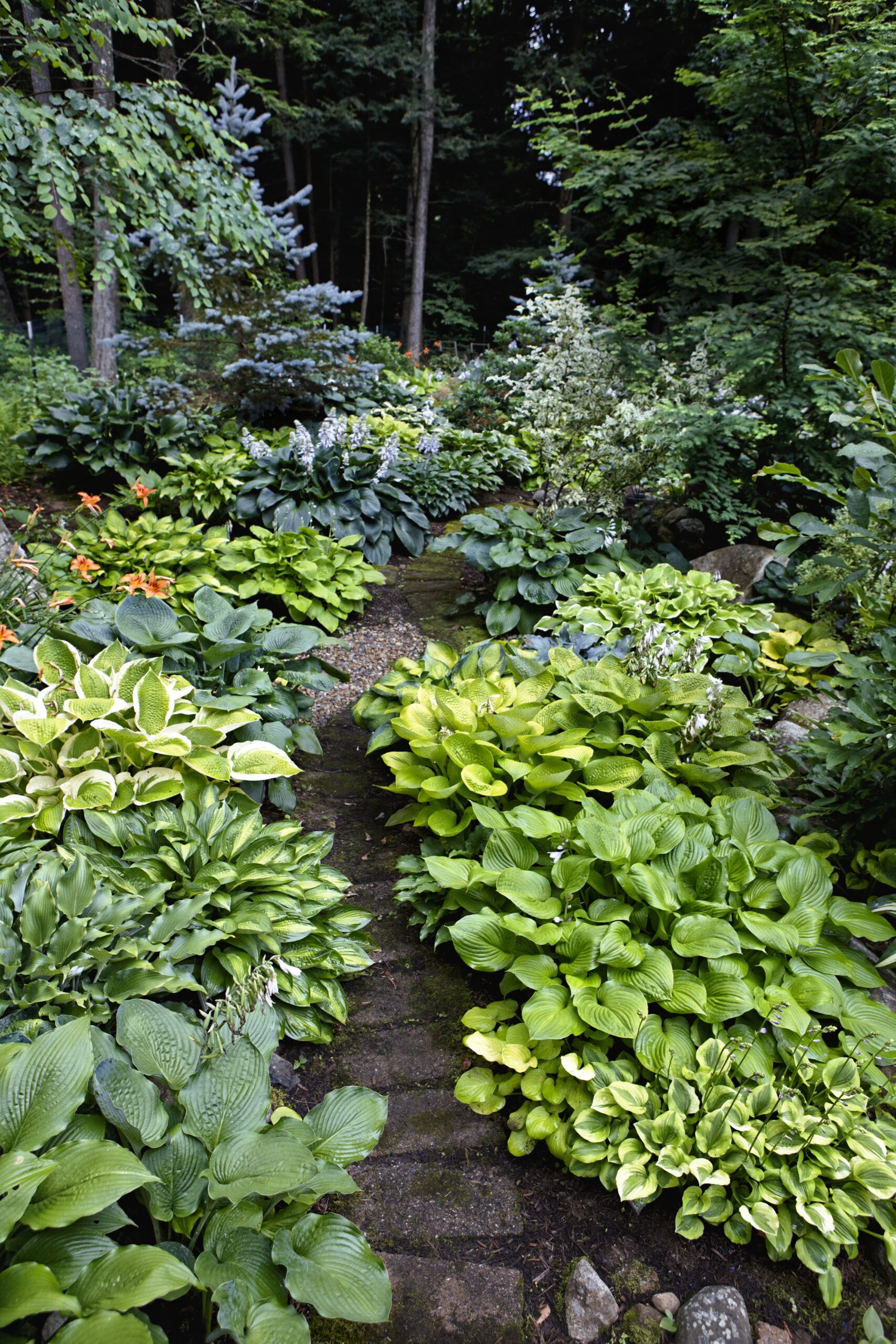
Hostas offer an unparalleled ability to bring color and texture to even the darkest corners of your garden. Their versatility allows for countless design possibilities, from creating bold focal points to softening hardscape elements, capturing both drama and subtlety in these vibrant plants.
When planning your hosta garden, use a mix of leaf sizes, shapes, and textures to create visual interest that captivates across every season. Incorporate hostas with different bloom times to extend the season of interest, improving the garden’s dynamism. Experiment with container plantings for added flexibility and height variation, adapting to different spaces with ease. Think about the mature size of each variety to achieve proper spacing and prevent overcrowding for strong, healthy growth. By thoughtfully combining various hosta varieties, you can transform any shady area into a lush, inviting garden space that provides beauty and interest throughout the growing season.
Punch of Color
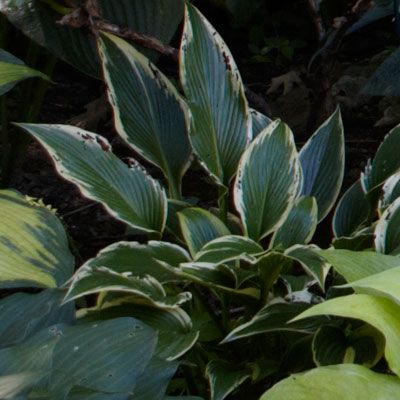
Planted against a backdrop of dark evergreens, hostas provide a punch of color to brighten a shady property line. Here, wide, rippled chartreuse leaves are paired with smooth, pointed variegated ones.
‘Fatal Attraction’
Dark green, 9-by-4-inch leaves with creamy white margins under lavender flowers that bloom in late summer. Grows up to 18 inches high and 36 inches wide in zones 3–8.
‘Prairie Moon’
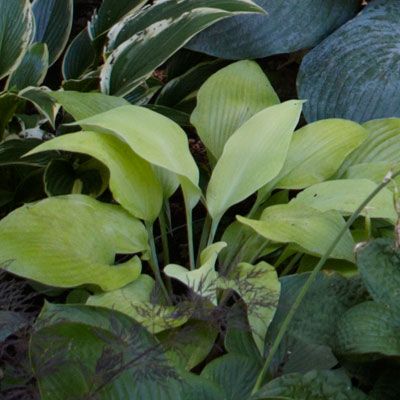
Thick, wedge-shaped yellow leaves have silvery undersides; lavender, bell-shaped flowers in August. Grows up to 15 inches high and 26 inches wide in zones 3–8.
‘Skylight’
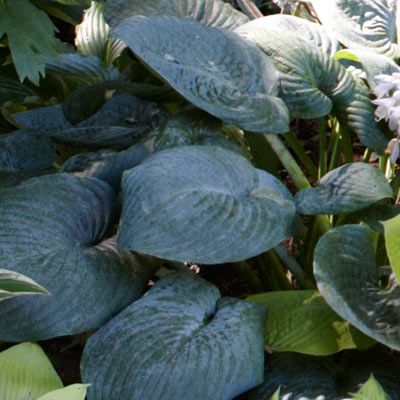
Heart-shaped blue leaves 10 inches wide sit under thick stems topped with lavender flowers from June to early July. Grows up to 18 inches high and 36 inches wide in zones 4–7.
‘Faith’
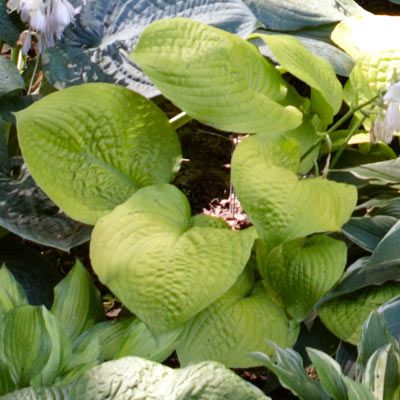
Rounded, ribbed, 16-by-15-inch yellow leaves; white flowers appear in early summer. Grows up to 16 inches wide and 40 inches high in zones 2–8.
‘Goober’
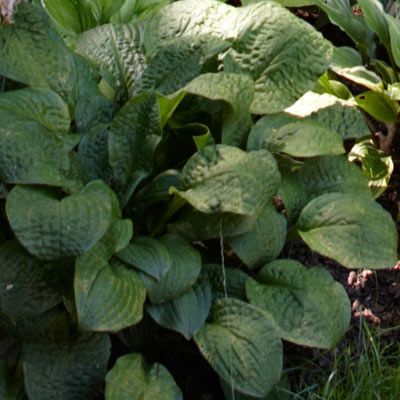
Puffy, rounded green leaves with purple-striped, bell-shaped flowers in midsummer. Grows up to 14 inches high and 18 inches wide in zones 2–8.
‘Christmas Pageant’
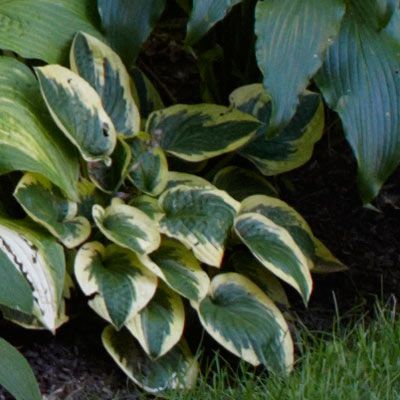
Rounded, rippled dark green centers with a wide margin that changes from creamy to white by midsummer, just before the pale lavender flowers bloom. Grows up to 20 inches high and 42 inches wide in zones 3–8.
‘Ringtail’
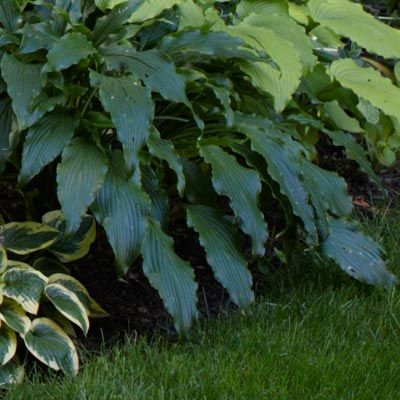
A vase-shaped grower with 10-inch-long, medium green leaves that twist and curl before coming to a point and pale lavender flowers in August. Grows up to 18 inches high and 24 inches wide in zones 3–8.
‘Dancing Queen’
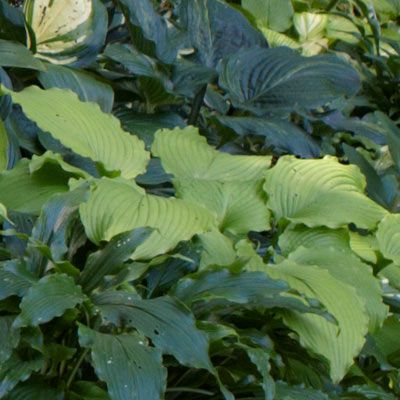
A large yellow hosta that holds its color all season, with ruffled, piecrust-like edges and pale lavender flowers in midsummer. Grows up to 18 inches high and 30 inches wide in zones 3–9.
‘Candle Glow’
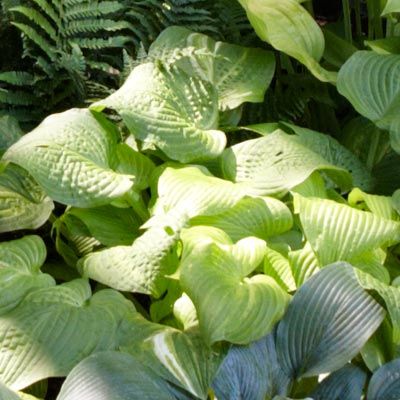
Small, 6-inch-long leaves with white centers are edged with a green or chartreuse margin under lavender flowers in late July. Grows up to 12 inches high and 15 inches wide in zones 3–8.
Roomy Bed for Mature Width
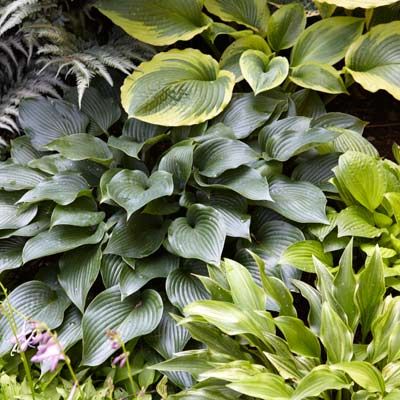
Planning for the mature width of the hosta before planting makes for a bed that gives room for each variety to grow without overcrowding. Here, the leaf textures and shapes, from deep ribbing on egg-shaped leaves to wavy edges on smooth ones, allow each hosta to stand on its own.
‘Pineapple Punch’
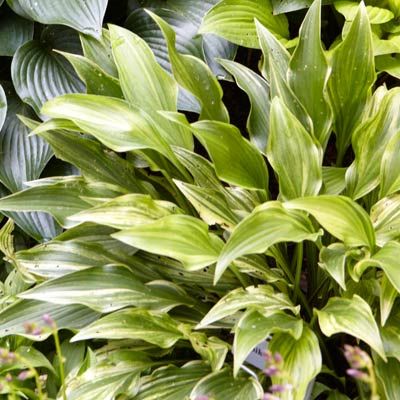
Long, matte, rippled green leaves with a narrow band of creamy white around the edges, with lavender flowers in midsummer. Grows to 15 inches high and 28 inches wide in zones 3–9.
‘Happiness’
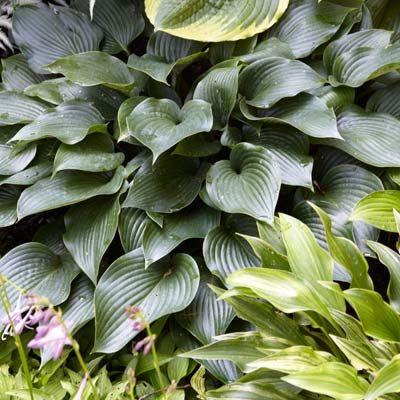
Thick, heart-shaped bluish-green leaves and dark purple blooms on 12-inch stems in midsummer. Grows up to 12 inches high and 18 inches wide in zones 3–8.
‘Ocean Isle’
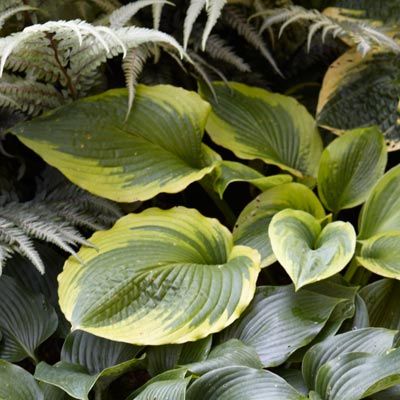
Large oval variegated leaves with green to blue-green centers and yellow margins under pale lavender flowers that bloom in early July. Grows up to 22 inches high and 48 inches wide in zones 3–8.
Bright Leaves for a Dark Corner
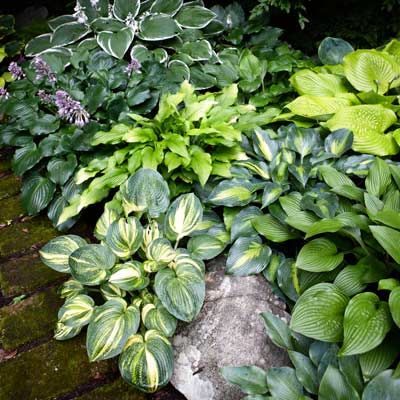
The yellow and gold leaves brighten this dark corner. Here the variegations echo the brighter solid-color varieties planted nearby.
‘Slick Willie’
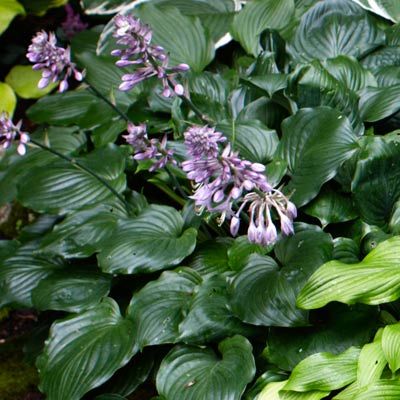
Glossy, oval dark-green leaves up to 8 inches long and 6 inches wide, and pale lavender flowers starting in July. Grows up to 20 inches tall and 48 inches wide in zones 3–8.
‘Frosted Jade’
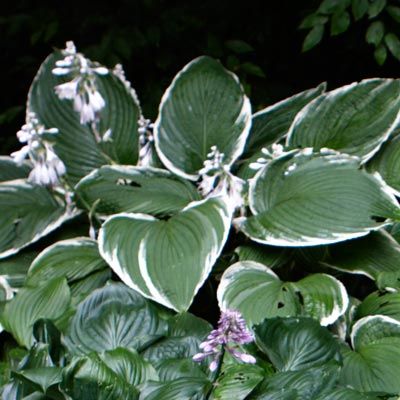
Most of the 12-by-9-inch leaves, which rest nearly horizontally, are jade green with a band of creamy white around the edges that matches the white blooms that arrive in June. Grows up to 28 inches tall and 36 inches wide in zones 3–8.
‘Chiquita’
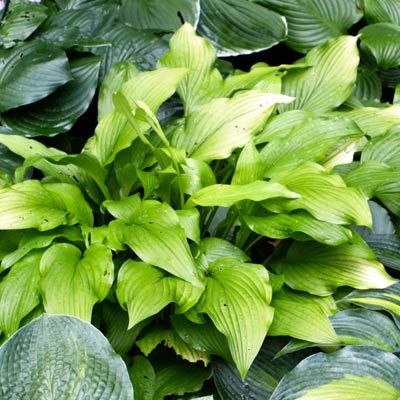
Wavy, 9-inch-long bright yellow leaves that turn lime green during the season, with lavender flowers in late July. Grows up to 24 inches high and 48 inches wide in zones 3–8.
‘Fried Green Tomatoes’
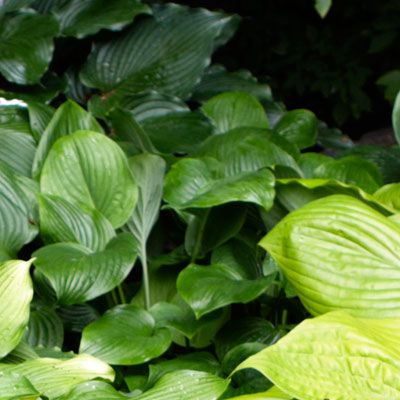
Large, heart-shaped green leaves that darken over the course of the season are paired with white, fragrant flowers that start blooming in July. Grows up to 28 inches high and 48 inches wide in zones 3–8.
‘Sum and Substance’
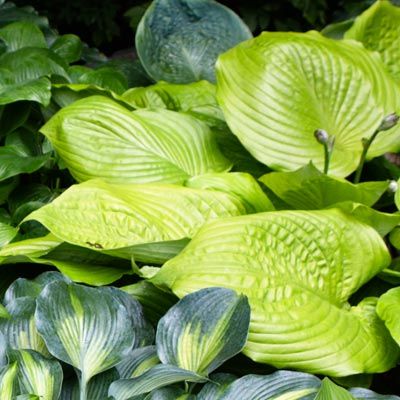
This massive variety reaches up to 60 inches wide, with thick, heart-shaped leaves of glossy yellow that can grow to 20 by 15 inches and fragrant white flowers on 38-inch stems starting in August. Grows up to 36 inches high in zones 3–8.
‘Lakeside Shore Master’
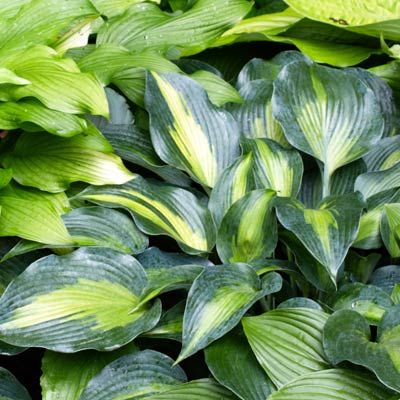
Starts with broad leaves that are blue-green in the spring before developing a yellow variegation in the center, with pale lavender flowers on 30-inch tall stems in midsummer. Grows up to 20 inches tall and 36 inches wide in zones 3–9.
‘Ice Age Trail’

A rare variegation with lots of white streaks on blue-green leaves that change to dark green during the season, with white flowers on 24-inch stems starting in June. Grows up to 16 inches high and 36 inches wide in zones 2–8.
‘Regal Rhubarb’
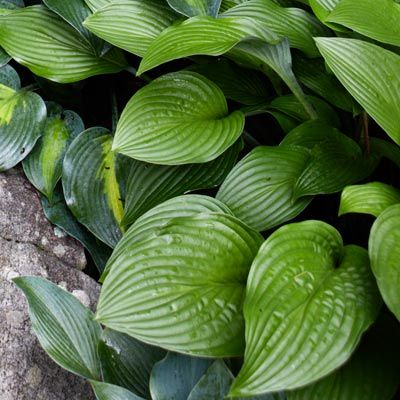
Bright red stems hold up 14-by-9-inch glossy, dark green leaves with pale lavender flowers that bloom in early July. Grows up to 30 inches tall and 36 inches wide in zones 3–8.
Reinforce Nearby Foliage
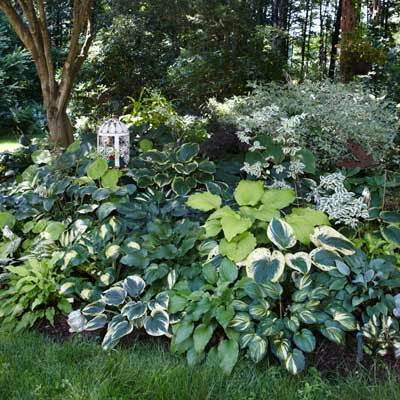
Tucked under a tree, this planting extends the bed to the variegated shrub nearby. The mostly white variegated hostas reinforce the shrub’s foliage colors.
‘Sagae’
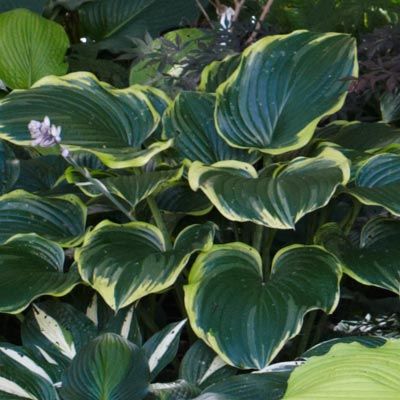
A tall mound of oval, variegated leaves of frosty bluish-green with white margins paired with white flowers on 34-inch stems. Grows up to 28 inches high and 36 inches wide in zones 3–8.
‘Goldbrook Glimmer’
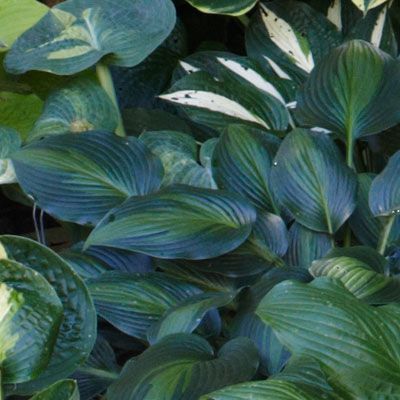
Sturdy blue leaves with a splash of yellow-green in the center, with lavender flowers in summer. Grows up to 20 inches tall and 30 inches wide in zones 3–8.
‘Regal Splendor’
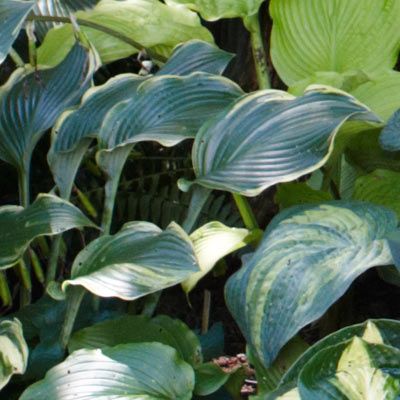
Long, wide blue leaves that come to a point with a creamy yellow or ivory margin and lavender flowers on stems as high as 6 feet in mid to late summer. Grows up to 36 inches high and wide in zones 3–9.
‘Cascades’
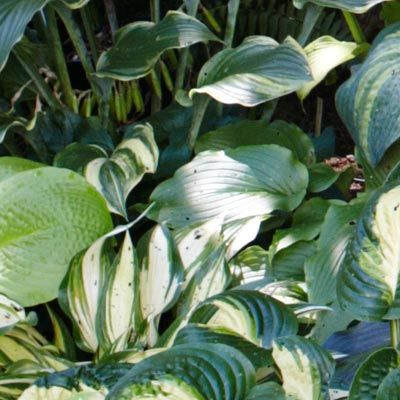
Long, wavy leaves with white centers surrounded by a chunky band of green and paired with white flowers on 34-inch stems in midsummer. Grows up to 15 inches high and 26 inches wide in zones 3–8.
‘Marrakech’
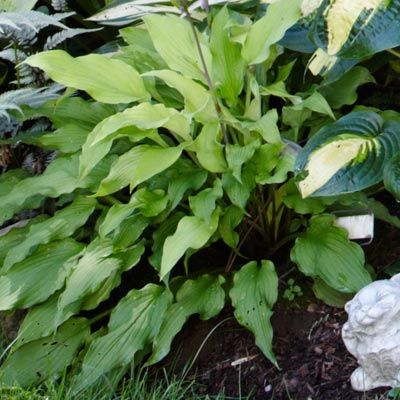
This small yellow hosta has lance-shaped leaves with wavy edges and pink flower buds and stems that produce light lavender flowers in midsummer. Grows up to 10 inches high and 18 inches wide in zones 3–8.
‘Aristocrat’
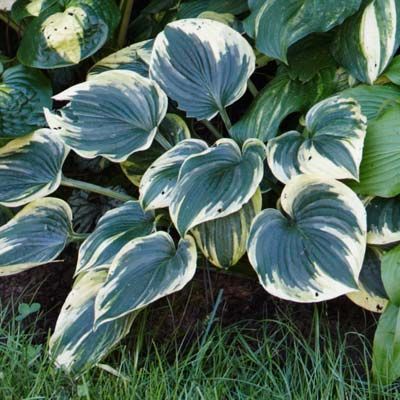
Lightly rippled, heart-shaped leaves covered mostly in a frosty blue-green color with a creamy yellow margin, with pale lavender flowers on 22-inch stems in midsummer. Grows up to 14 inches high and 22 inches wide in zones 3–9.
‘Golden Oriole’

It starts bright yellow before turning green later in the season, with thin, 13-inch-long lance-shaped leaves and lavender flowers in late summer. Grows up to 18 inches high and 41 inches wide in zones 3–8.
‘Eleanor Lachman’
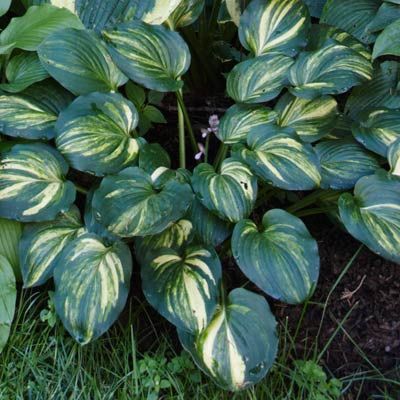
Small, thick leaves with white centers and dark green margins and lavender flowers that bloom in July. Grows up to 10 inches high and 12 inches wide in zones 3–8.
‘Fragrant Blue’
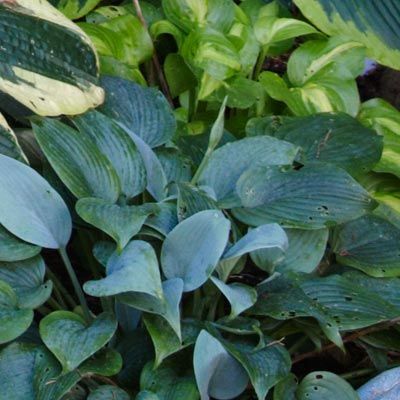
Thick, dusty blue leaves with a slight ribbing paired with fragrant, light lavender flowers on 22-inch stems in midsummer. Grows up to 18 inches high and 30 inches wide in zones 3–9.
‘Mount Tom’
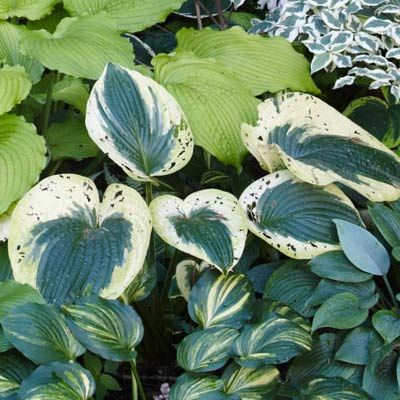
Rounded, ribbed leaves up to 10 inches wide in mostly blue rimmed with creamy yellow that turns to white and pale lavender flowers in early summer. Grows up to 19 inches high and 47 inches wide in zones 3–9.
‘Warwick Comet’
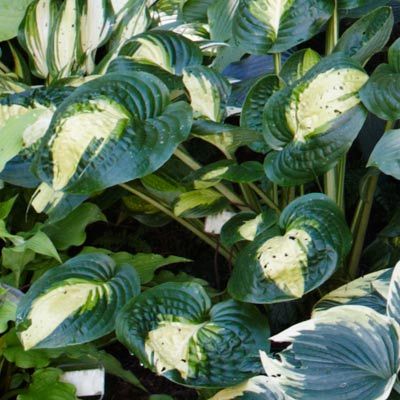
Round, cupped, glossy dark green leaves splashed with creamy white centers; white flowers in midsummer. Grows up to 16 inches high and 30 inches wide in zones 2–8
Large, Textured Leaves
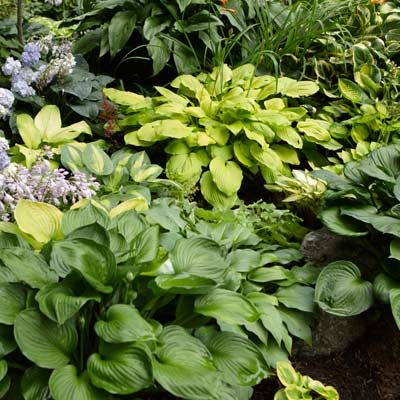
Large-leaved varieties look even better with heavy ribbing or slight upward cupping. The pale lavender flowers on these hostas work well with the mophead hydrangea at the back of the bed.
‘Sweet Susan’
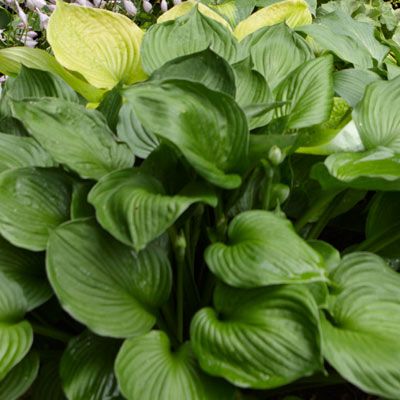
Medium green color with corrugation on leaves up to 5 inches wide, with fragrant, lavender flowers that bloom on 25-inch stems in mid-August. Grows up to 18 inches tall and 30 inches wide in zones 3–9.
‘Mountain Sunrise’
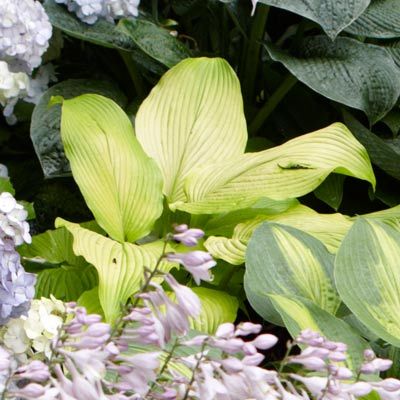
The 11-inch-long leaves start yellow before turning chartreuse during the season, with white flowers in early July. Grows up to 28 inches high and 36 inches wide in zones 3–8.
‘Paradise Glory’
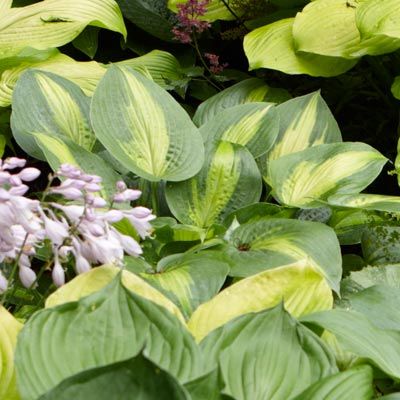
Thick, yellow-gold leaves with a very wide band of blue-green around the edges and pale lavender flowers on 34-inch tall stems in midsummer. Grows up to 25 inches high and 40 inches wide in zones 3–9.
‘Kiwi Gold Rush’
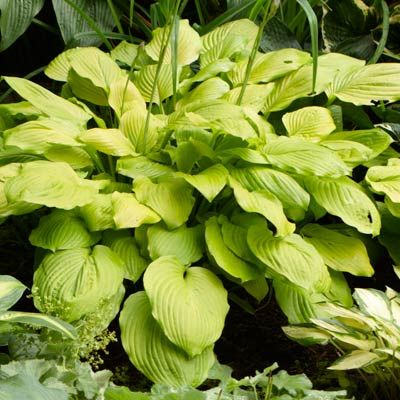
Rounded, pointed 5-inch-wide bright golden yellow leaves, with light lavender flowers in midsummer. Grows up to 15 inches tall and 24 inches wide in zones 2–8.
‘Rainforest Sunrise’

Slug-resistant leaves start light green, then turn dark green with golden centers before light lavender flowers arrive on 24-inch stems in midsummer. Grows up to 8 inches high and 16 inches wide in zones 3–9.
Informal Feel
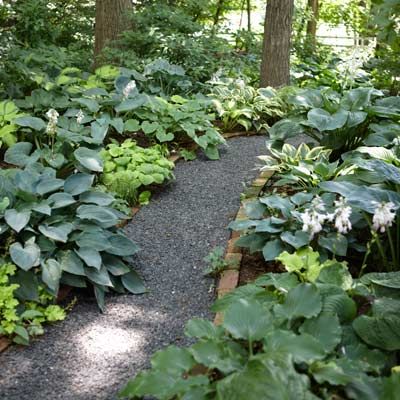
A stroll on this path is the perfect opportunity to reach out and touch these hostas, which provide an informal cottage feel as they spill over onto the walk.
‘Locomotion’
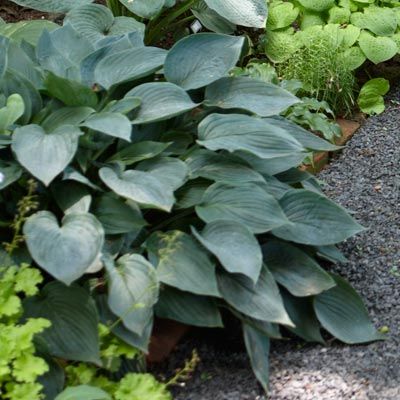
Blue-green leaves with distinct ribbing that nearly fold inward and lavender flowers that bloom in summer. Grows up to 10 inches high and 18 inches wide in zones 3–8.
‘Banana Muffins’
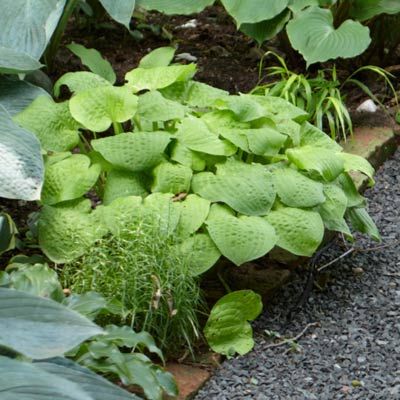
Rounded, ribbed light green leaves about 4 1/2 inches wide paired with soft lavender flowers on 33-inch stems starting in July. Grows up to 28 inches high and 18 inches wide in zones 3–8.
‘Ruby Slippers’

Medium green leaves up to 5-by-4 inches with a shiny appearance and rippled texture under purple flowers that start in September. Grows up to 16 inches tall and 30 inches wide in zones 3–8.
‘Summer Music’
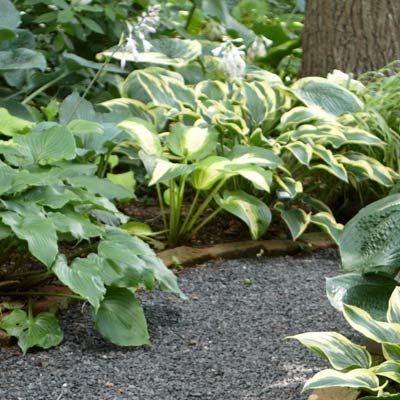
Large, egg-shaped leaves that feature a subtle twisting with a white middle surrounded by jagged margins of lime green, then darker green, with lavender flowers in summer. Grows up to 15 inches high and 24 inches wide in zones 3–9.
‘Margin of Error’
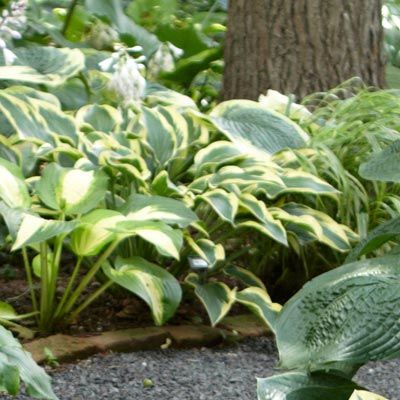
Dark green leaves with creamy white margins and soft lavender flowers on 24-inch stems in late summer. Grows up to 18 inches tall and 15 inches wide in zones 3–8.
‘Border Bandit’
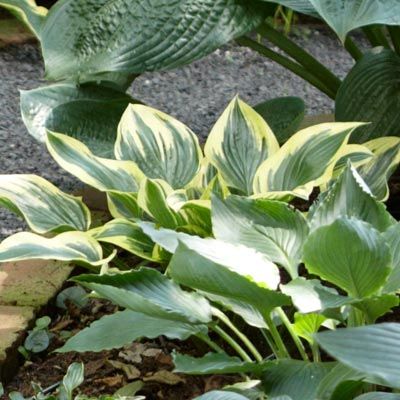
Glossy blue-green, spear-shaped leaves with creamy white edges that can streak toward the middle, with lavender flowers in late July. Grows up to 9 inches high and 15 inches wide in zones 3–8.
‘Reginald Kaye’
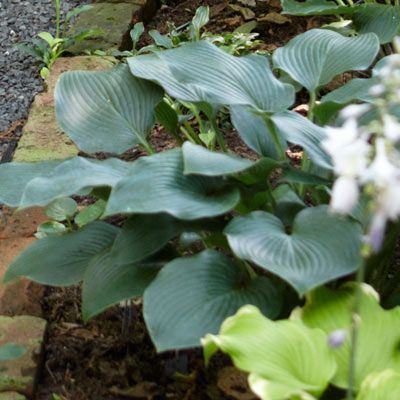
Ribbed, heart-shaped green leaves with lavender flowers in midsummer. Grows up to 28 inches high and 24 inches wide in zones 3–8.
Added Drama
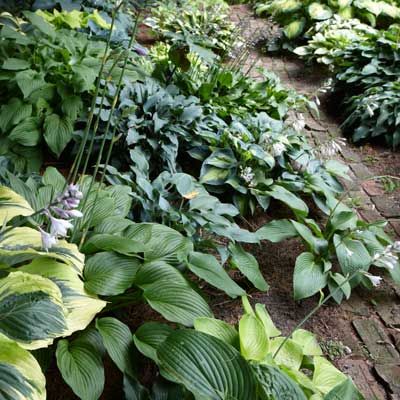
The stems that bear the small- to medium-sized tubular-shaped flowers make a dramatic exit out of the mass of foliage. Filled with as many as 75 flowers, these stems can reach up to 40 inches high, depending on the variety.
‘Liberty’
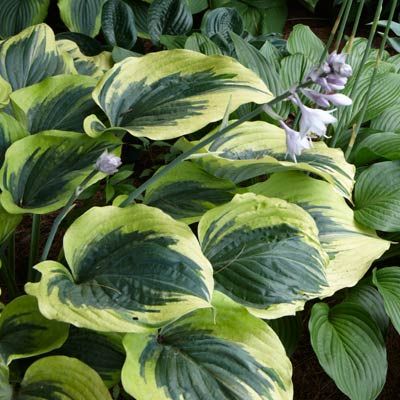
Thick, dark green leaves edged with a broad golden yellow border that changes to a creamy color in summer at about the time lavender flowers appear on 40-inch stems. Grows up to 26 inches high and 39 inches wide in zones 3–9.
‘Fortunei Hyacinthina’
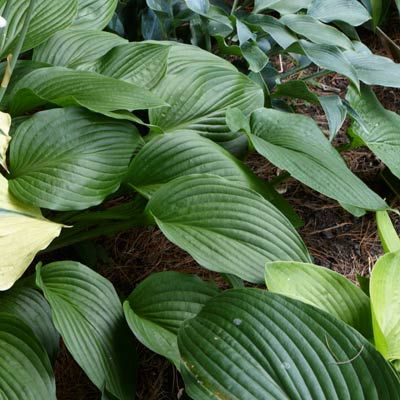
Large egg-shaped leaves, which can grow to 12-by-8 inches, start blue-green before developing a gray-green color later in the season, with pale lavender flowers in midsummer on 34-inch stems. Grows up to 18 inches high and 24 inches wide in zones 3–8.
‘Golden Friendship’
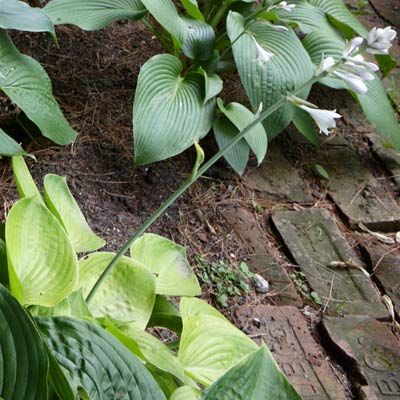
Round golden yellow leaves with plenty of corrugation and that cup upward, paired with lavender flowers in summer. Grows up to 22 inches tall and 44 inches wide in zones 3–8.
‘Blue Diamond’
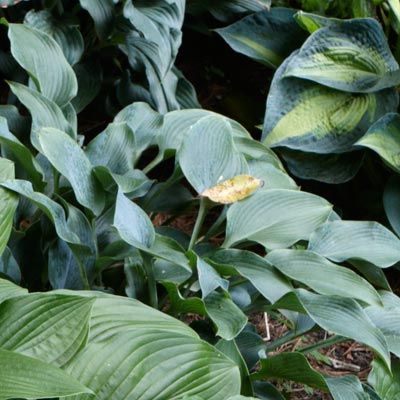
Blue-green hosta, considered one of the bluest varieties around, that has thick, egg-shaped leaves with slightly wavy edges under soft lavender flowers in midsummer. Grows up to 18 inches high and 12 inches wide in zones 3–8.
‘Green Angel’
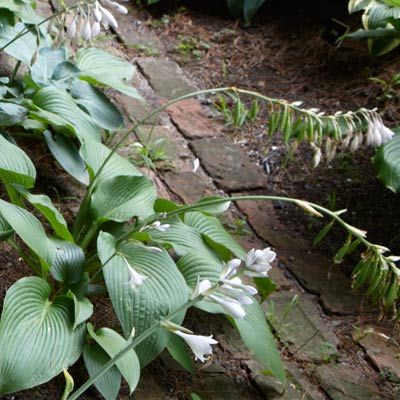
Large, up to 14-inch-wide ribbed leaves that are mostly flat, with white flowers in summer. Grows up to 28 inches high and 36 inches wide in zones 3–8.
‘Heat Wave’
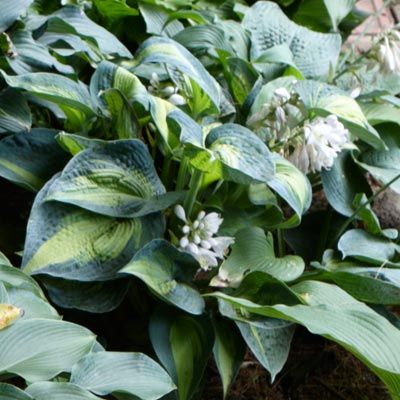
Features a wide band of blue around chartreuse in spring before the center turns bright gold and the margin a deeper blue-green, with white flowers on 16-inch stems in midsummer. Grows up to 12 inches high and 18 inches wide in zones 3–9.
‘Venetian Blue’
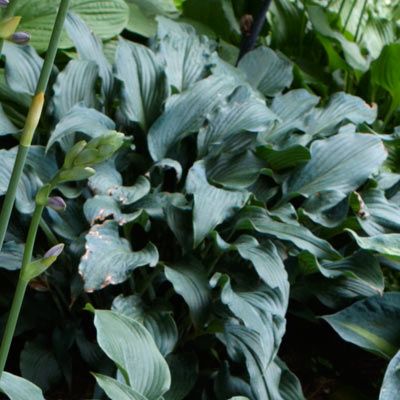
Forms a wide mound of 6-inch-long narrow, wavy blue-green leaves, with lavender flowers starting in mid-July. Grows up to 18 inches high and 24 inches wide in zones 3–8.
White Variegation
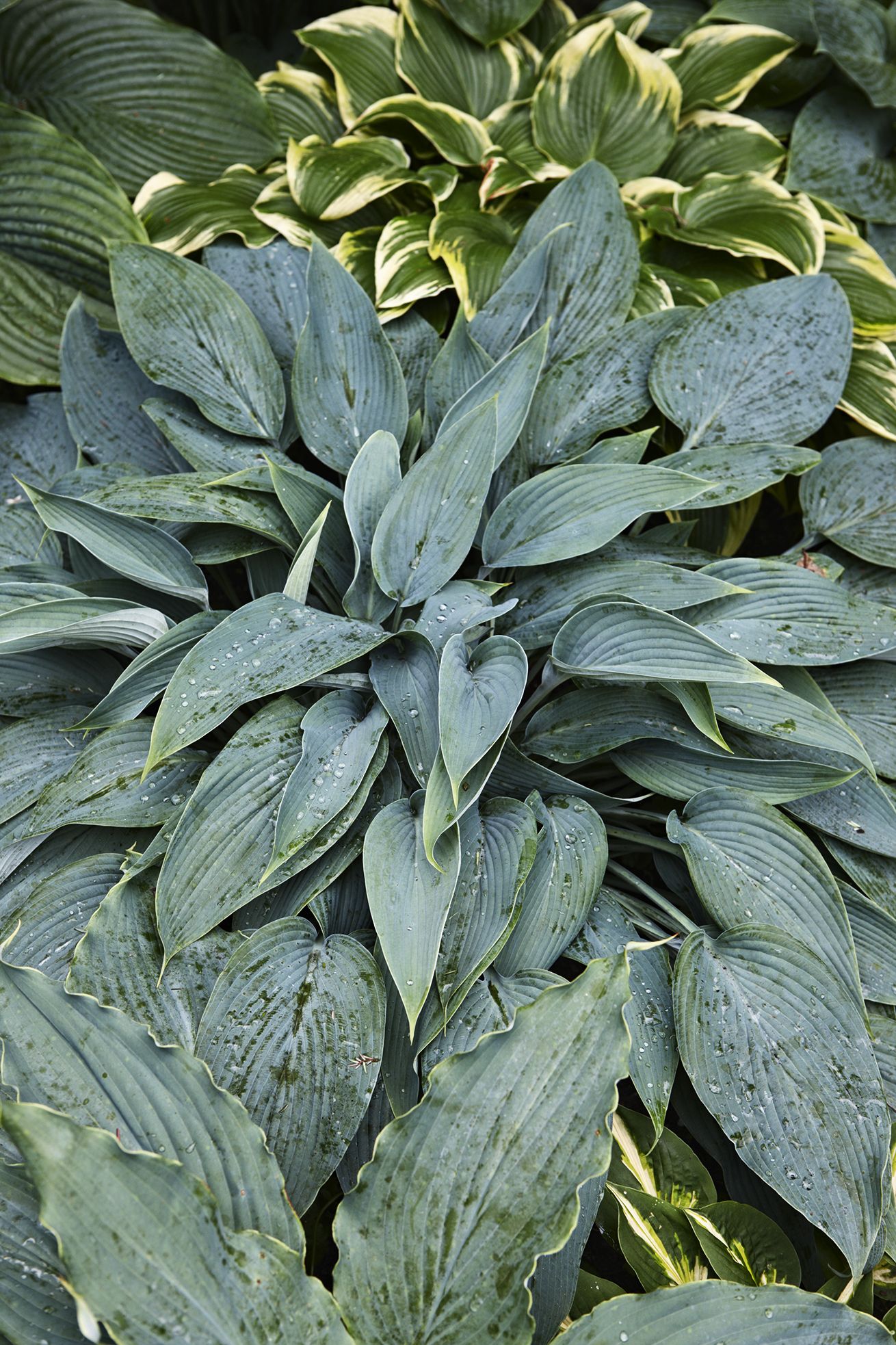
Variegated varieties always draw attention, even more so when a healthy dose of white is included. Here the white variegation moves throughout the bed on varieties with matte, almost frosted finishes.
‘Venetian Blue’

Pointed dark green leaves with thick white margins under 26-inch stems bearing pale lavender flowers in midsummer. Grows up to 18 inches high and 26 inches wide in zones 3–9.
‘Americana’
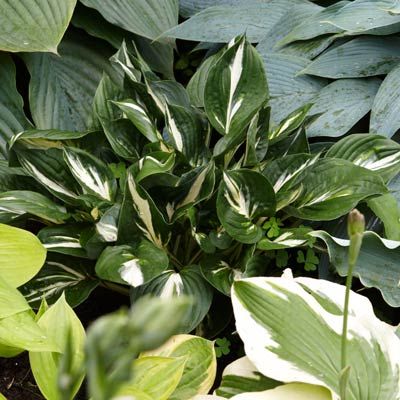
Thick leaves with white centers surrounded by dark green, paired with lavender flowers on 20-inch stems in midsummer. Grows up to 18 inches tall and 24 inches wide in zones 3–9.
‘Neptune’
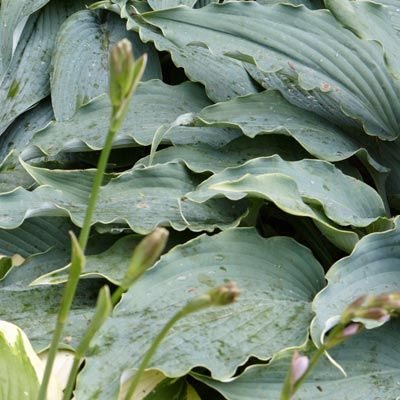
Blue-green, wedge-shaped leaves featuring dramatic ripples, with lavender flowers in August. Grows up to 24 inches high and 26 inches wide in zones 3–8.
‘Awaking Angel’
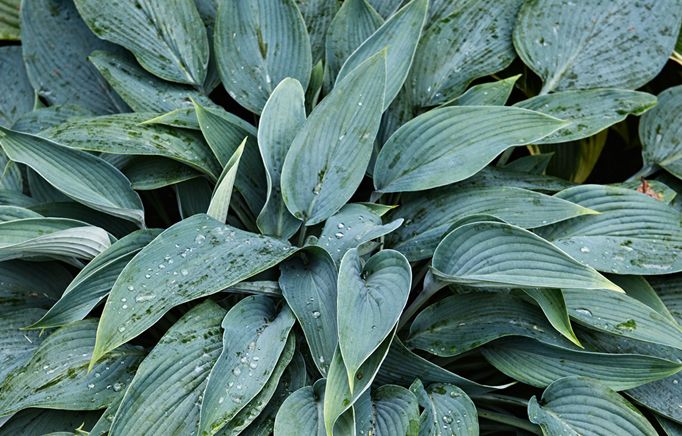
Pointed leaves up to 6 inches long in a frosted blue-green, with soft lavender flowers on 26-inch stems starting in late July. Grows up to 15 inches high and 32 inches wide in zones 3–8.
‘Empress Wu’
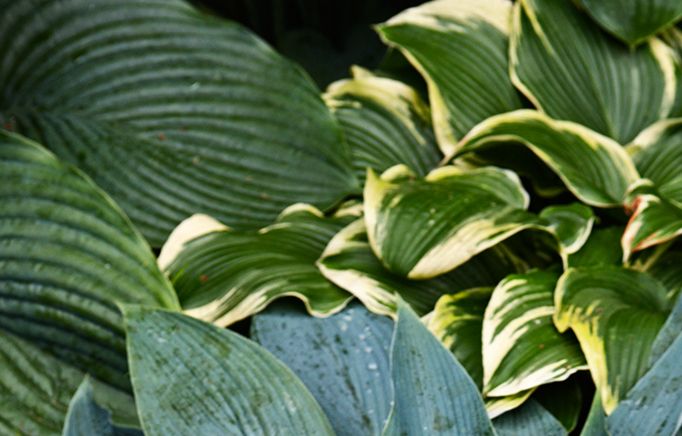
A real focal point in the garden with deeply corrugated dark green leaves up to 18 inches wide and long, with pale purple flowers in midsummer. Grows up to 4 feet high and 6 feet wide in zones 3–9.
‘Memories of Dorothy’
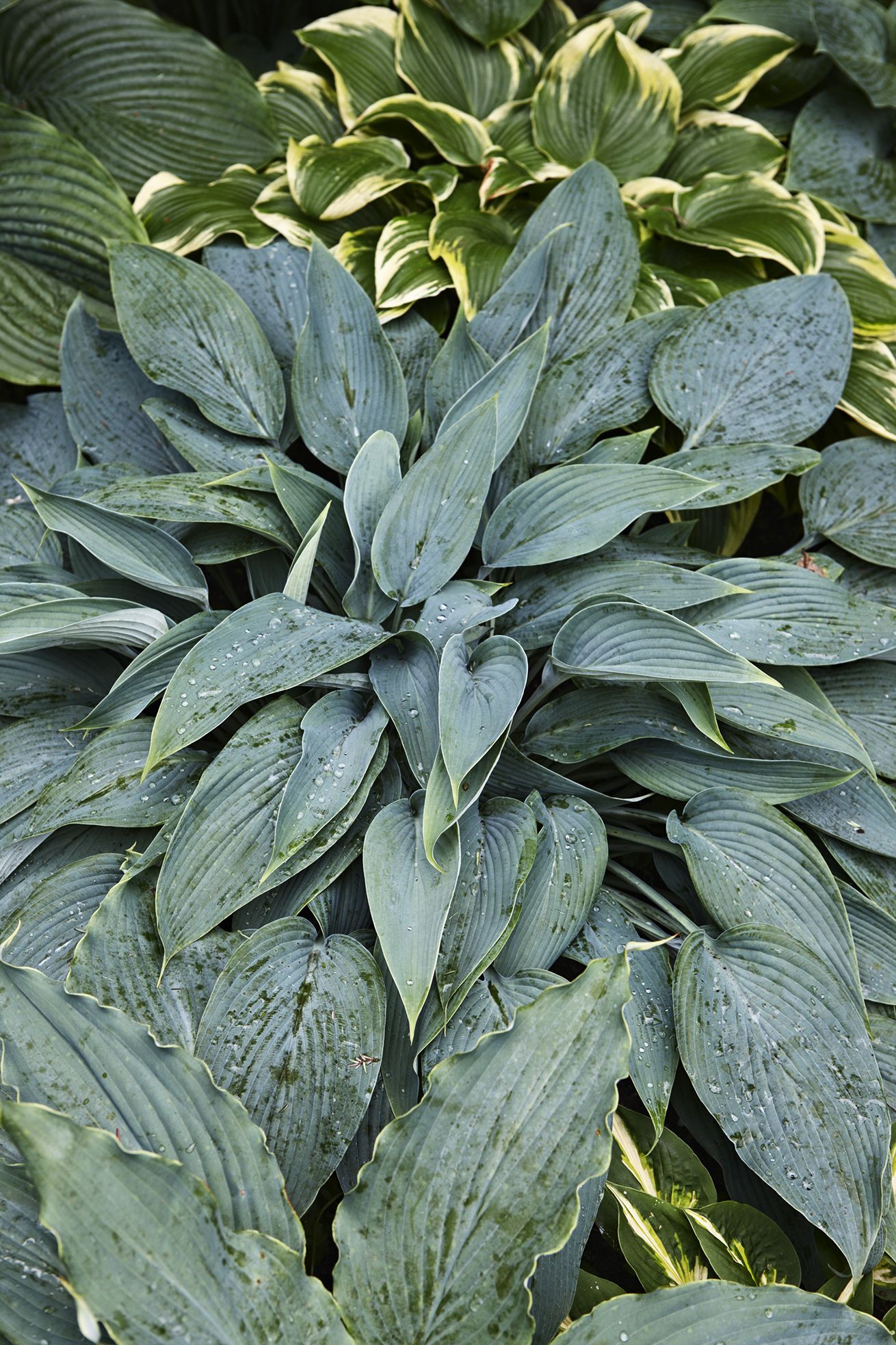
Wide, heart-shaped leaves with green centers, lighter green streaking, and yellow-to-white edges under pale lavender flowers on 32-inch stems in mid-July. Grows up to 18 inches high and 42 inches wide in zones 3–8.
